Our trip to Australia and New Zealand started in Melbourne, Australia.
Melbourne
We spent several days recovering from the flight and getting to know Melbourne. It is a beautiful city with many interesting features. Our guide, Ronan, carefully explained the history and cultural background of Melbourne and every other place we visited on this trip. We were with a Grand Circle tour in a group of about thirty Americans. We were blessed to have my cousin Bob Jordan and his charming wife, Shelly, with us on this tour. We did a tremendous amount of walking in Melbourne which caused a lot of back pain for me at first, and then, I adapted to it and had a great time after the first painful few days.
One of the activities we did in Melbourne was to find the Botanical Gardens. That was a lot of walking, but we saw a lot of interesting plants and had a great time. We also learned to use the buses in Melbourne, finally.
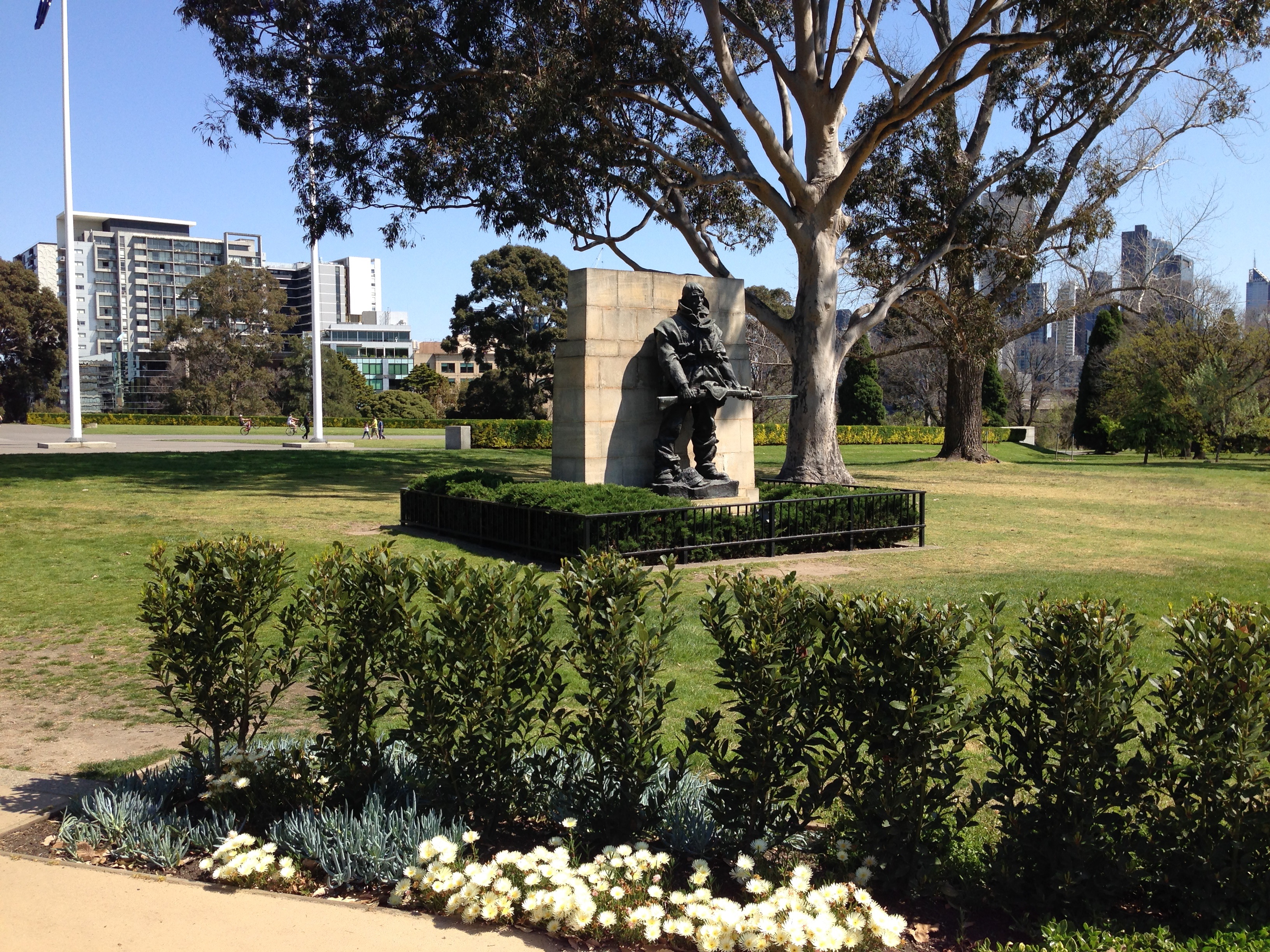
One of the sights was the park around the War Memorial. This was one of the statues.
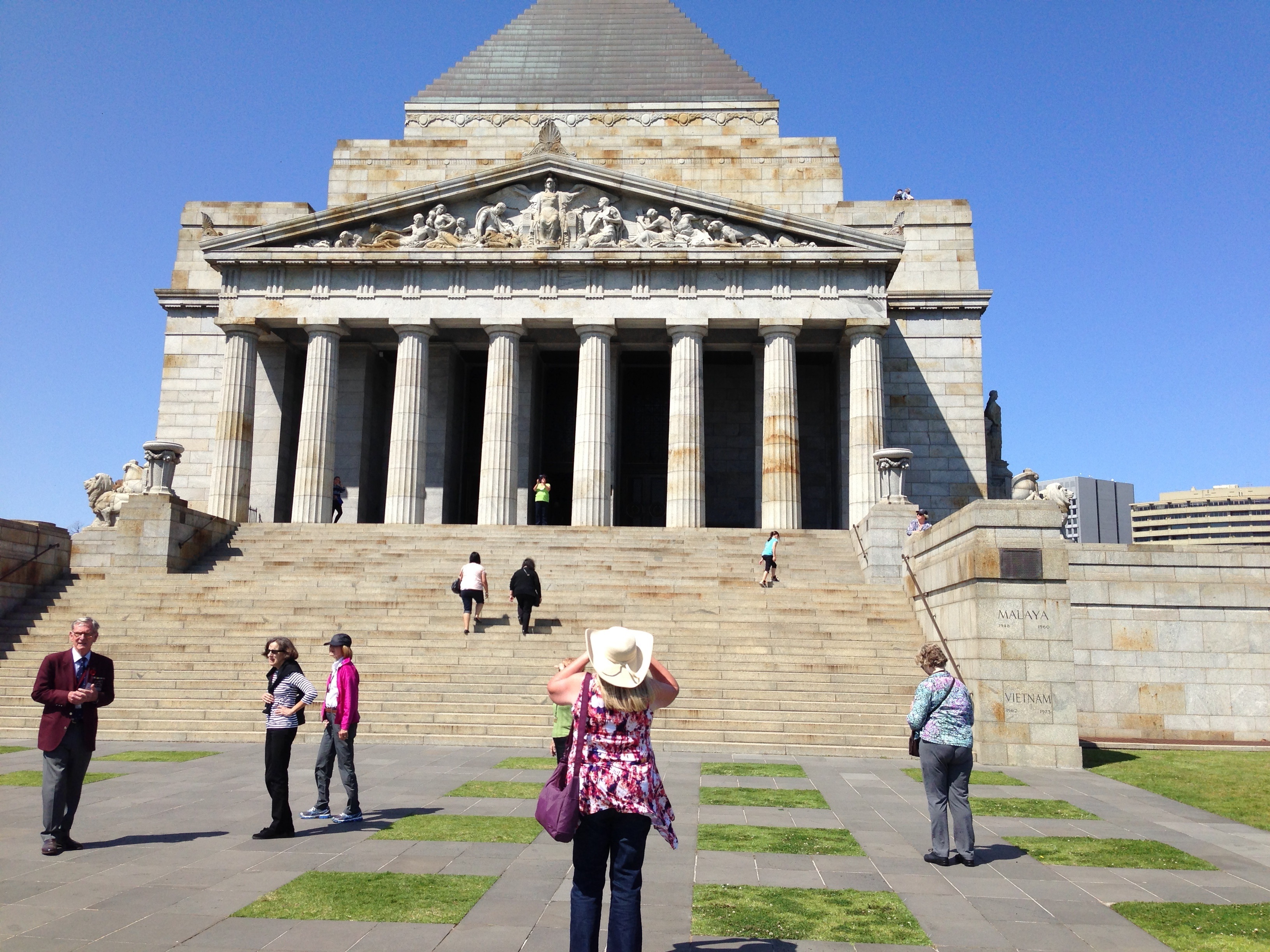
One of the local tours in Melbourne was the war memorial. It honors the many fallen ANZAC soldiers at Gallipoli, WWII and Viet Nam. It was impressive as well as somber.
After a few days in Melbourne (pronounced "Melbin" locally) we flew to Alice Springs. This is in central Australia and is in the outback. Alice Springs was founded over a hundred years ago as the central point of a national telegraphic communication system. The surveyer who picked the site chose it primarily due to the apparently abundant source of water in the nearby Todd River as it was named. Unfortunately, the Todd river is a dry bed of sand most of the year. Nevertheless, Alice Springs is still a going concern today although the original telegraph system is no longer in service.
Alice Springs
Interestingly enough, Alice is the headquarters for several important services essential to the well-being and survival of the sparse and widespread Australian population: the Royal Flying Doctors and the School of the Air. Since Australia is about as large as the United States but with a fraction of the population, medical and educational services have to be very mobile. For additional information on the Royal Flying Doctors, please visit: Royal Flying Doctors. For more details on the School of the air, please visit Australian School of the Air.
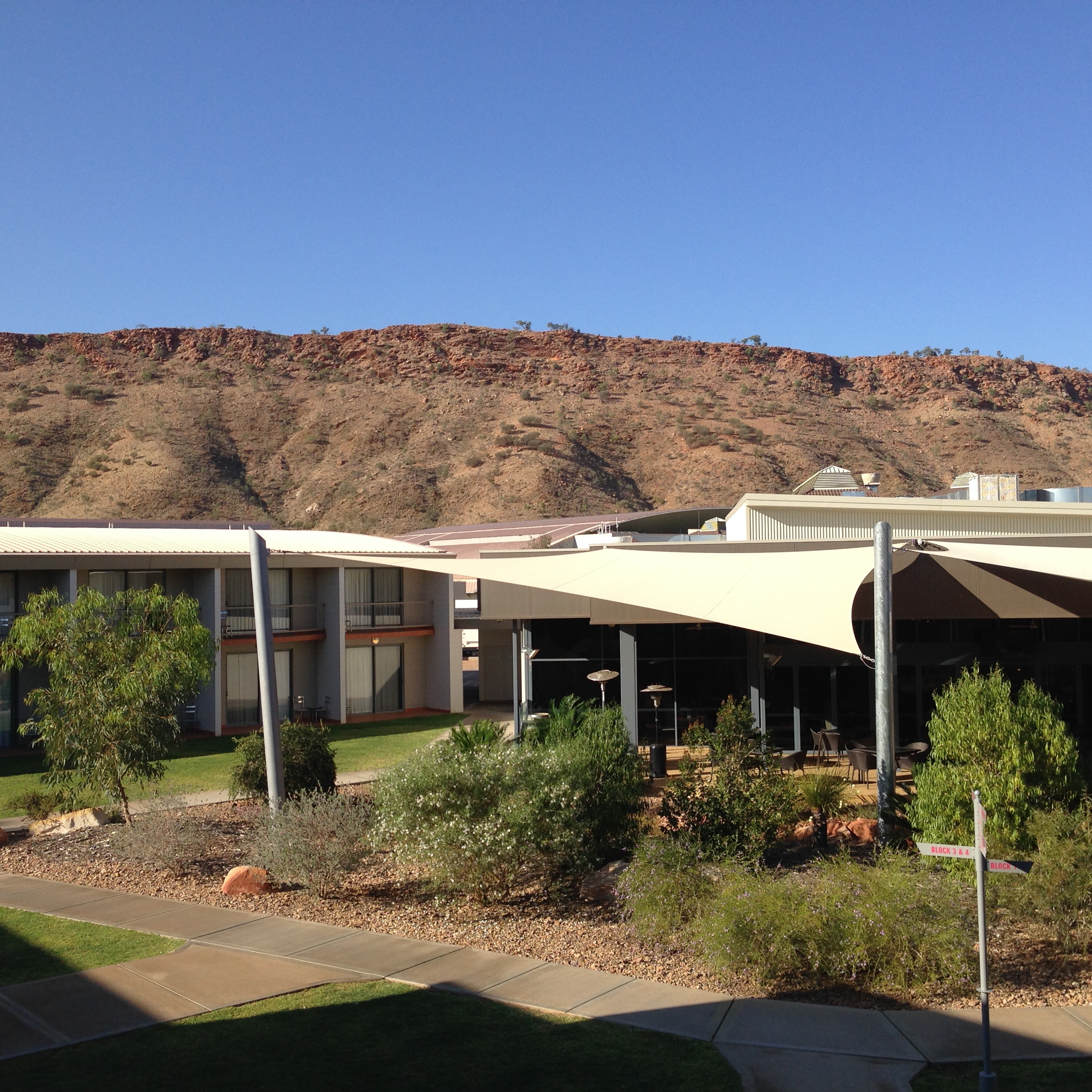
Shown above is our hotel in Alice Springs.
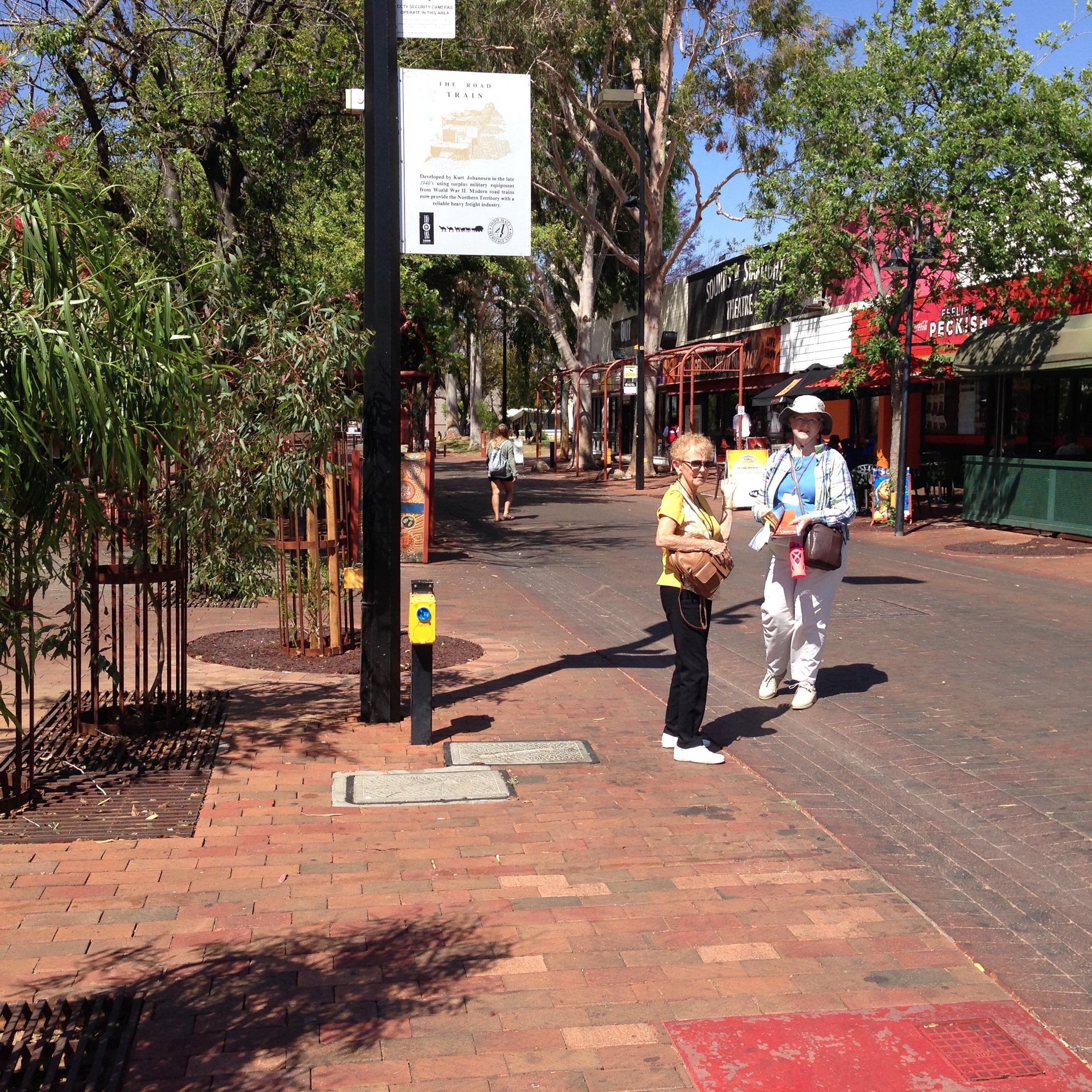
Here are Shelly and Colleen shopping in Alice Springs. There was a lot of aboriginal art, both sculture and paintings available
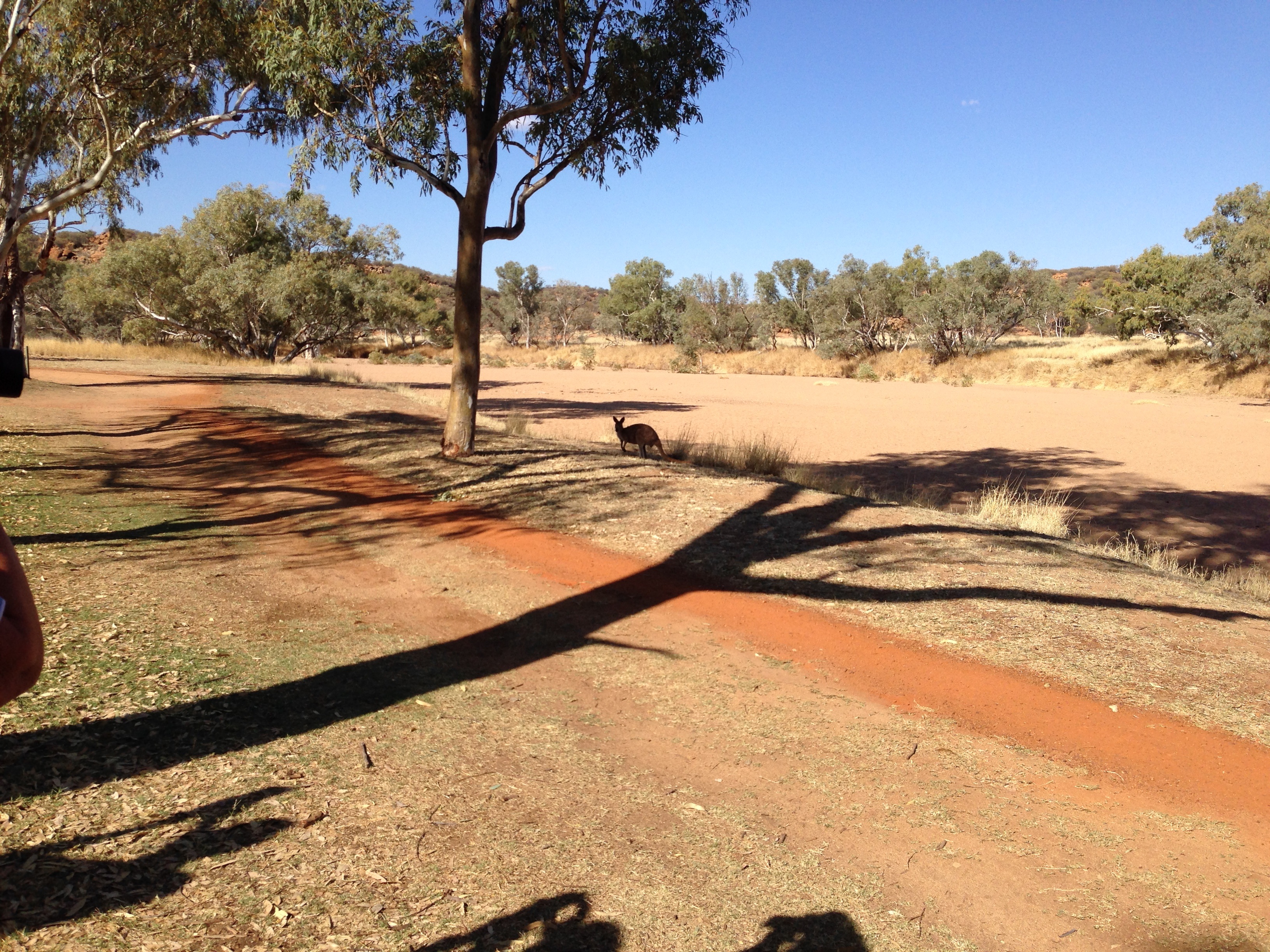
Here is the Todd River near the old telegraph station. Note the wallaby that was nearby. It would not get too close, but it did not seem to fear us.
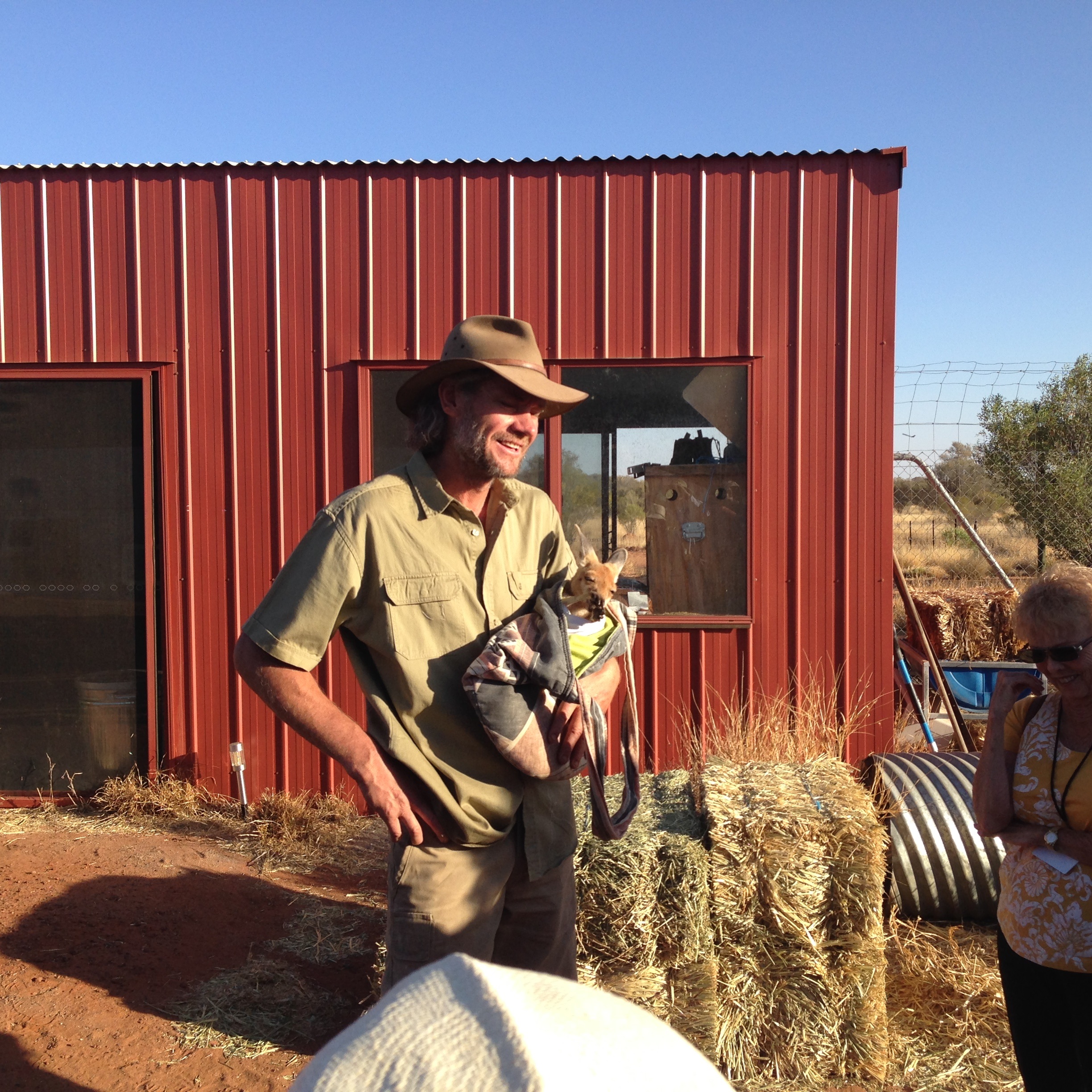
One of the most interesting outings was our visit to the kangaroo sanctuary near Alice Springs. This is Brolga holding Jack, an orphaned joey that he rescued. Often kangaroos are hit by automobiles at night. Although the mother kangaroo usually dies, the joey in her pouch often survives the impact without injury, but needs food, warmth and protection to survive. Brolga provides this and usually manages to release the animals back into the wild after they mature.
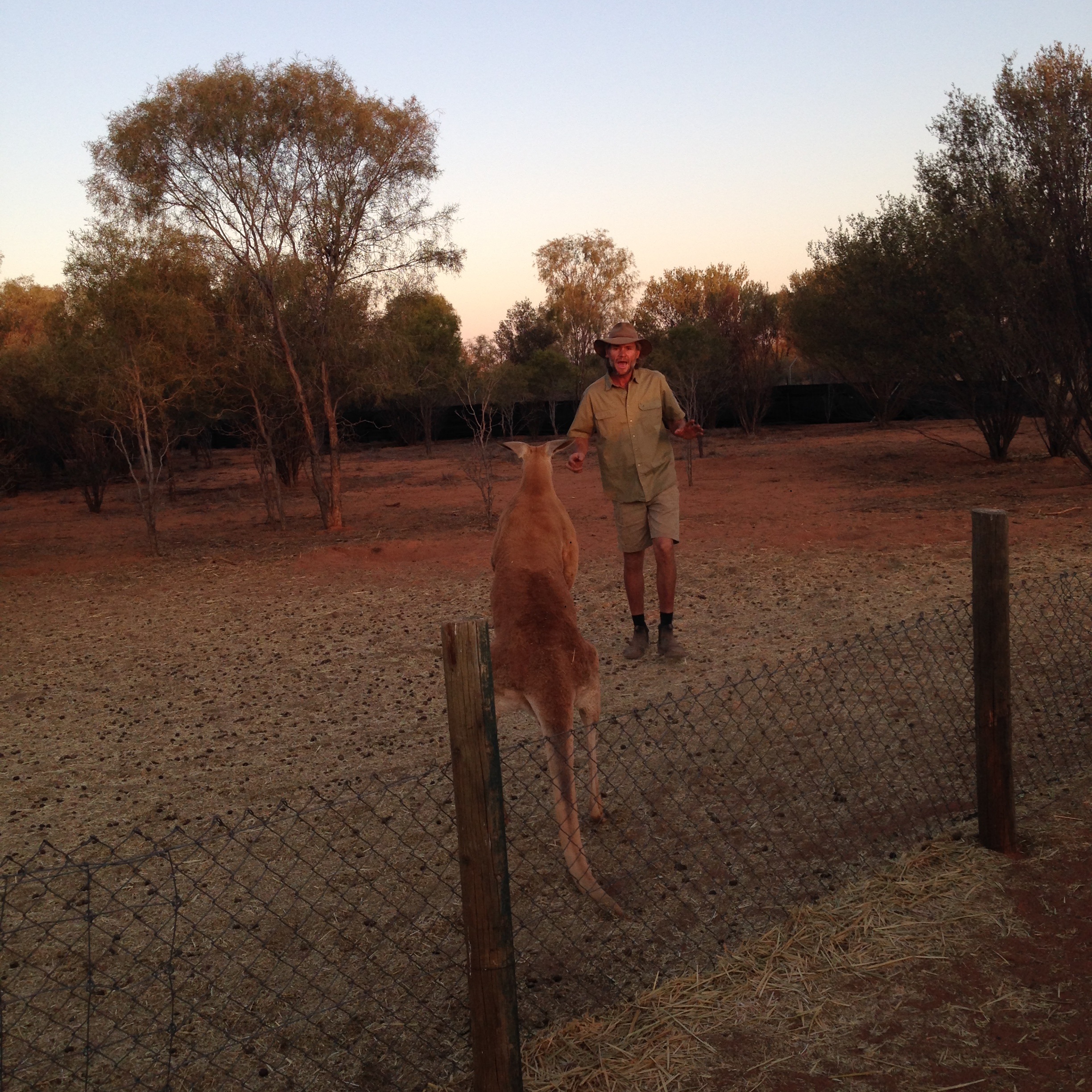
One alpha male kangaroo that Brolga raised is Roger. Roger assumes a standing human is challenging him for dominance. Brolga demonstrated this by interacting with Roger. For a better understanding of this entire sanctuary operation, please visit kangaroosanctuary.com.
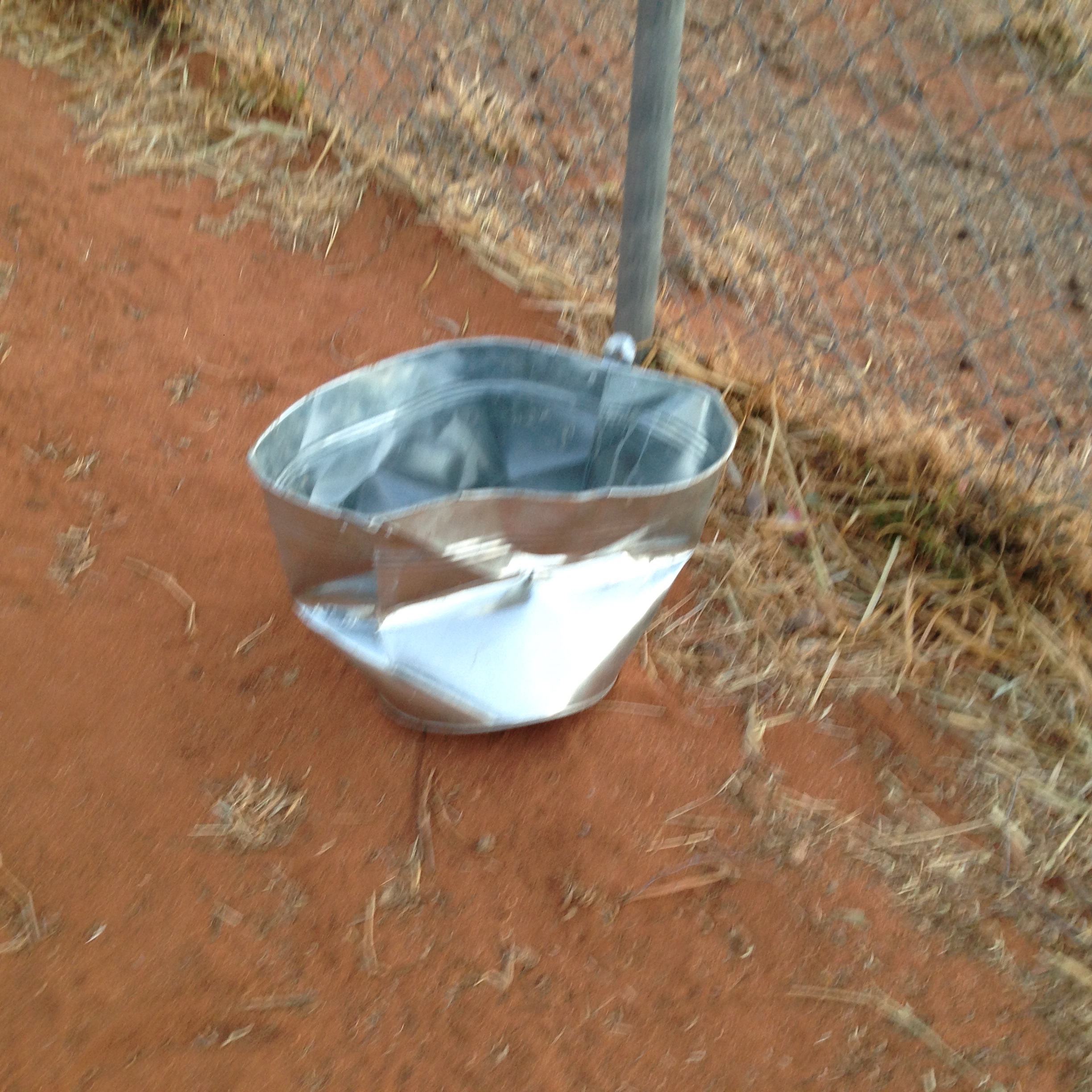
Roger is very strong. When agitated, he likes to crush metal buckets.
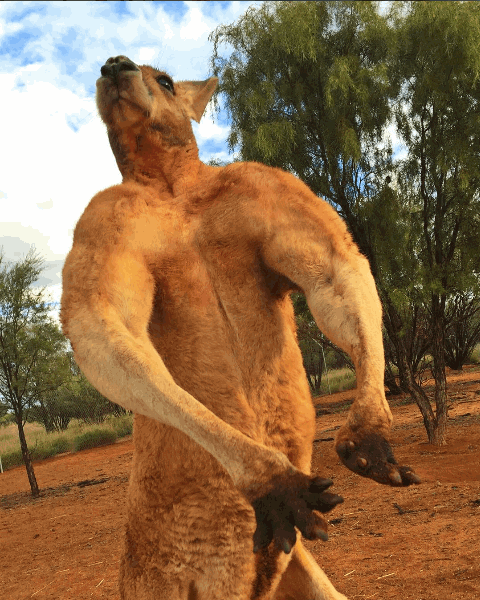
Now you see why you do not want to wrestle with Roger!
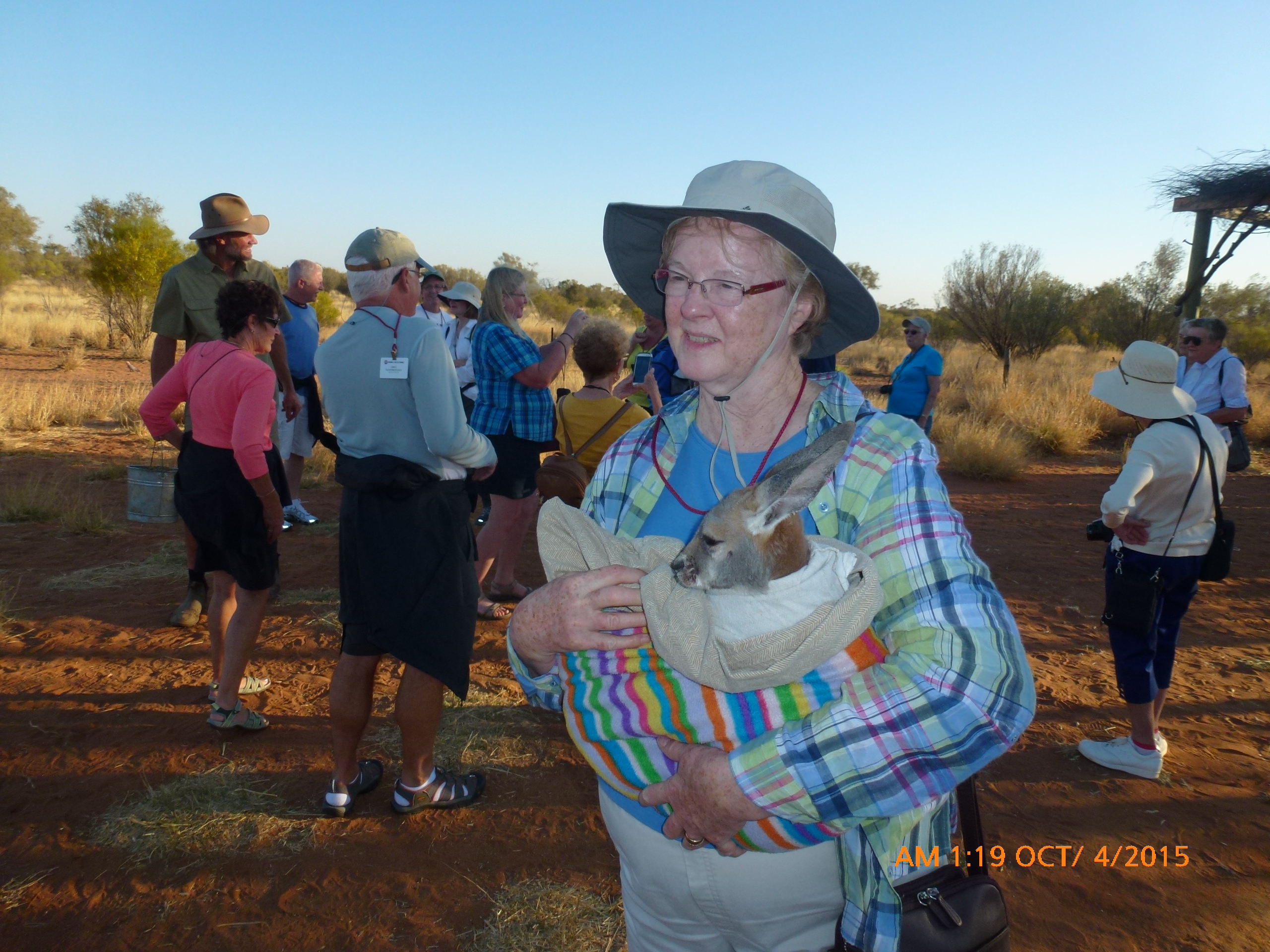
This is Colleen holding Indy, one of the babies. (Thanks to Bob & Shelly for the photo)
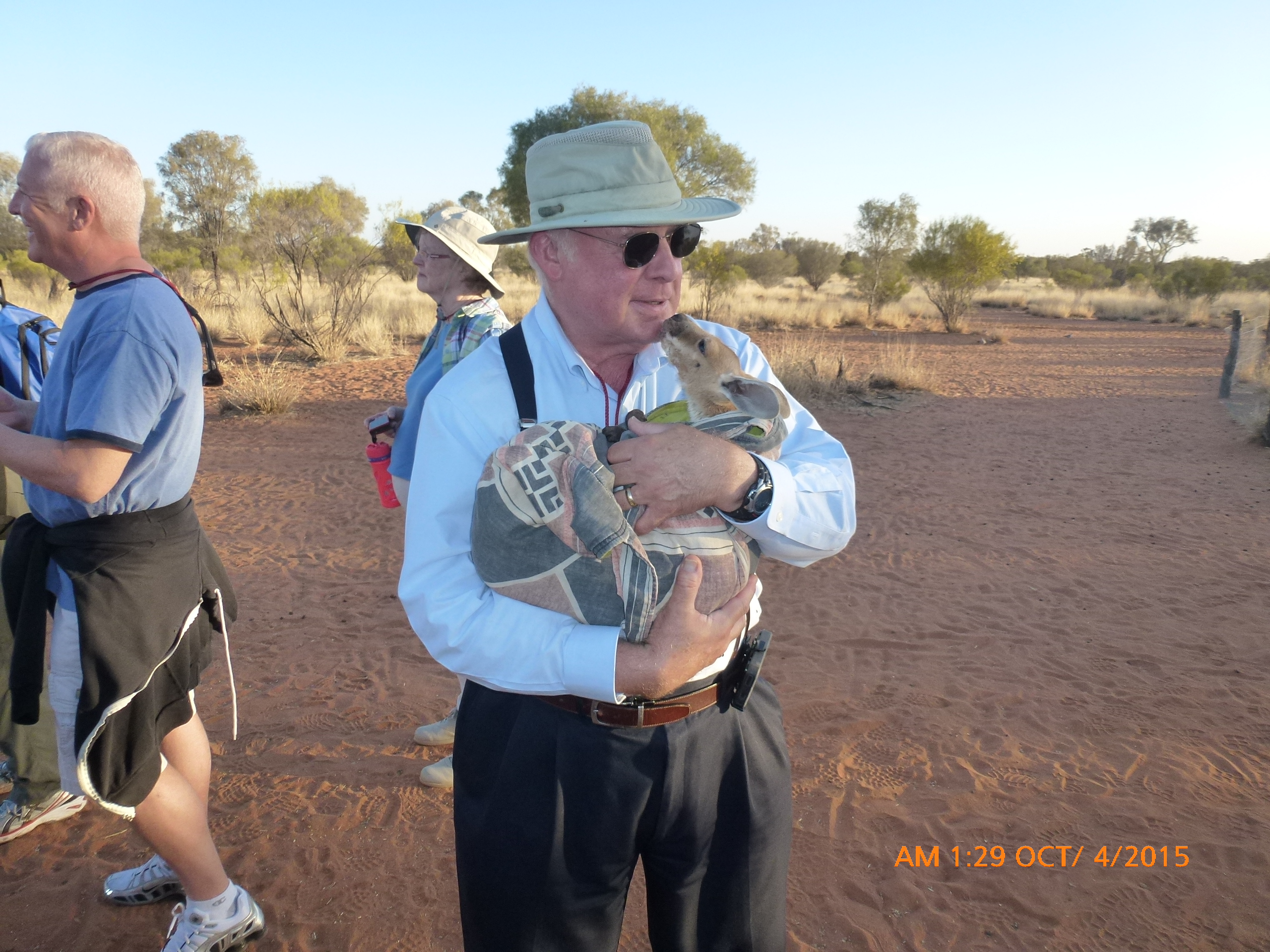
And here I am getting a kangaroo kiss from Jack, the other joey that Brolga brought that evening. (Thanks to Bob & Shelly for the photo)
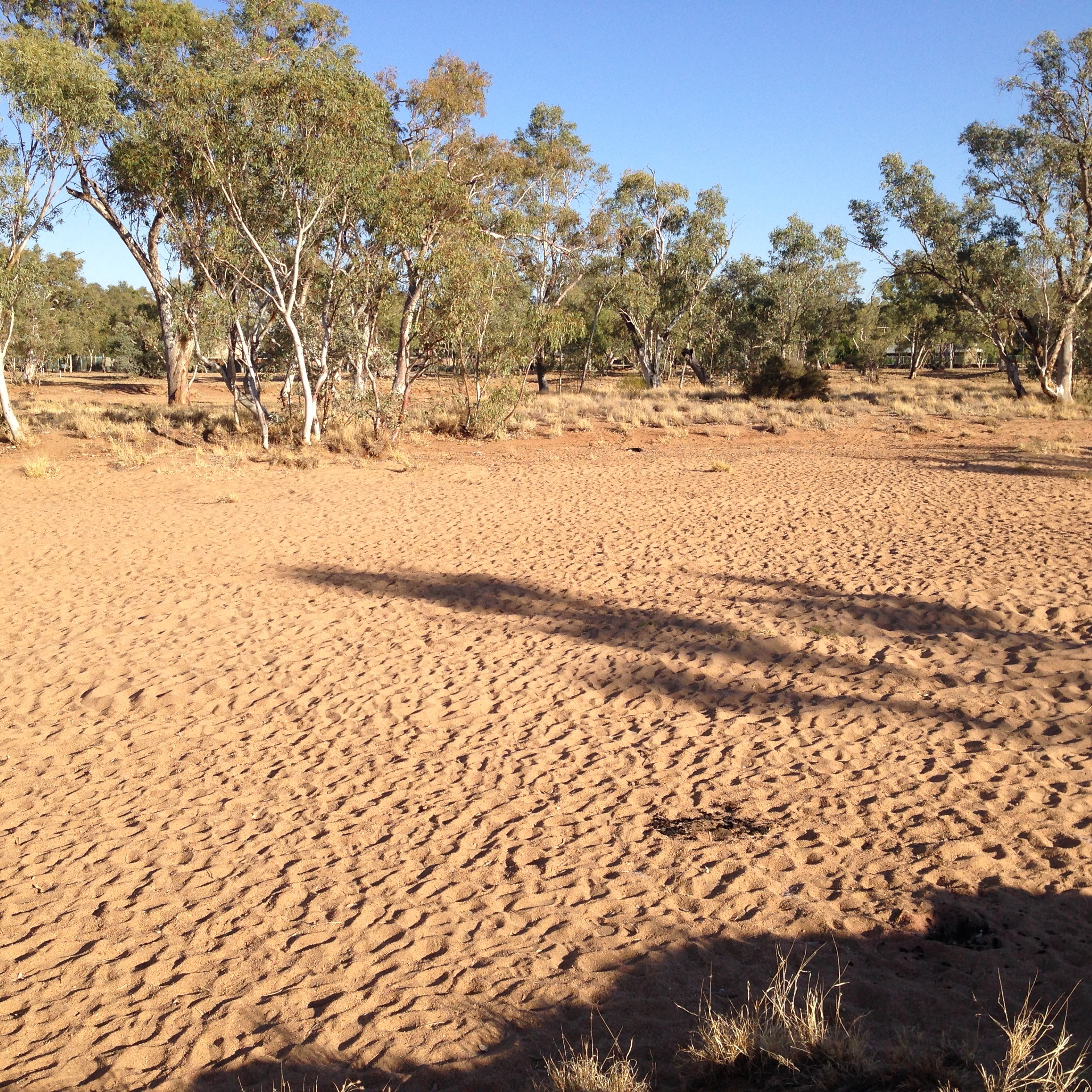
Here is another look at the Todd River from near our hotel in Alice Springs. There is an annual "boat race" on this river. The boats are powered by feet; it may be the only boat race that takes out flood insurance, since actual water in the river would cause the race to be cancelled. For more information, please visit:
Henley on Todd Regatta
Coach Trip
On October 4, 2015, we boarded a coach for the ride from Alice Springs to Uluru (AKA Ayres Rock)
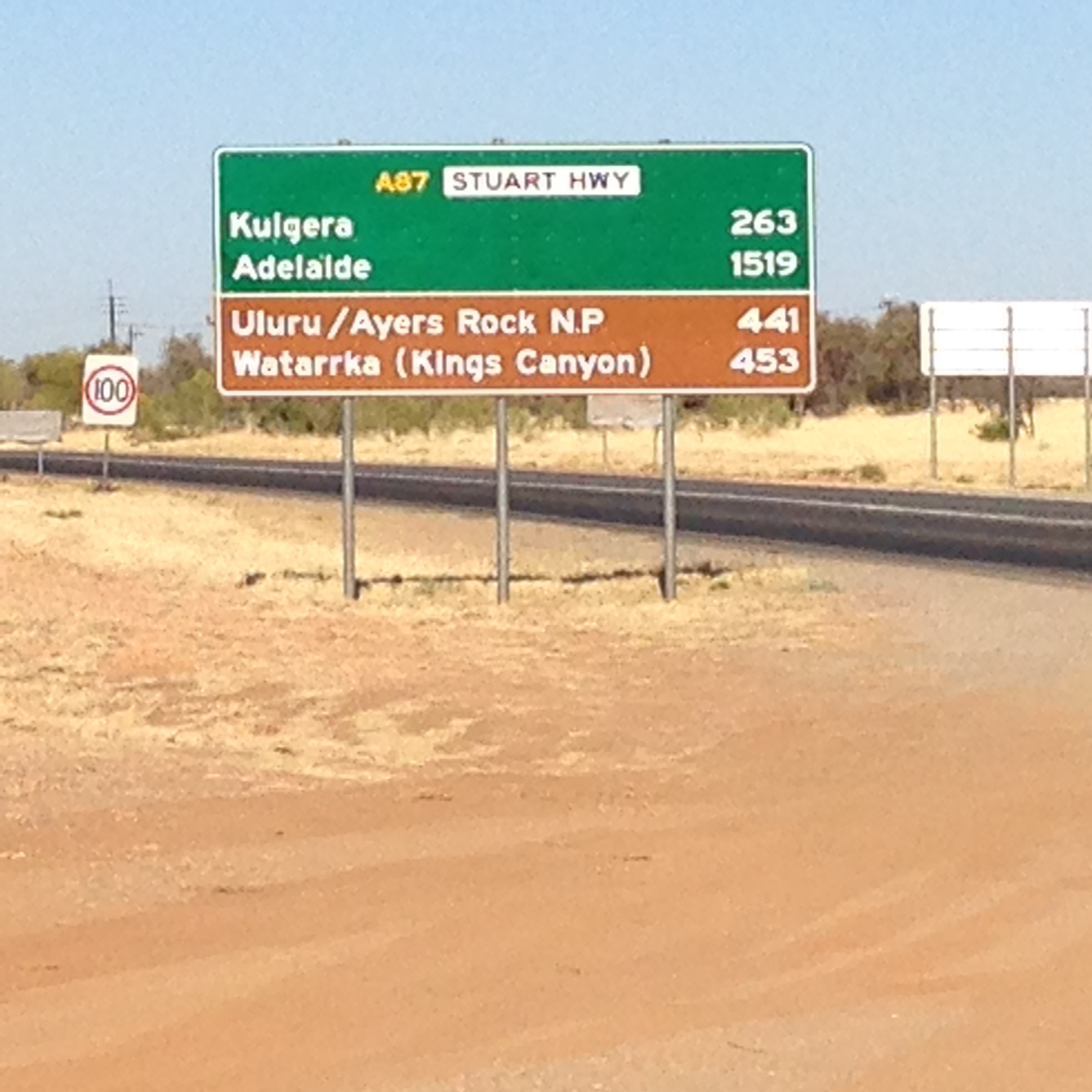
This is the start of our coach trip to Uluru. We had just left Alice Springs. (Distances are in kilometers.)
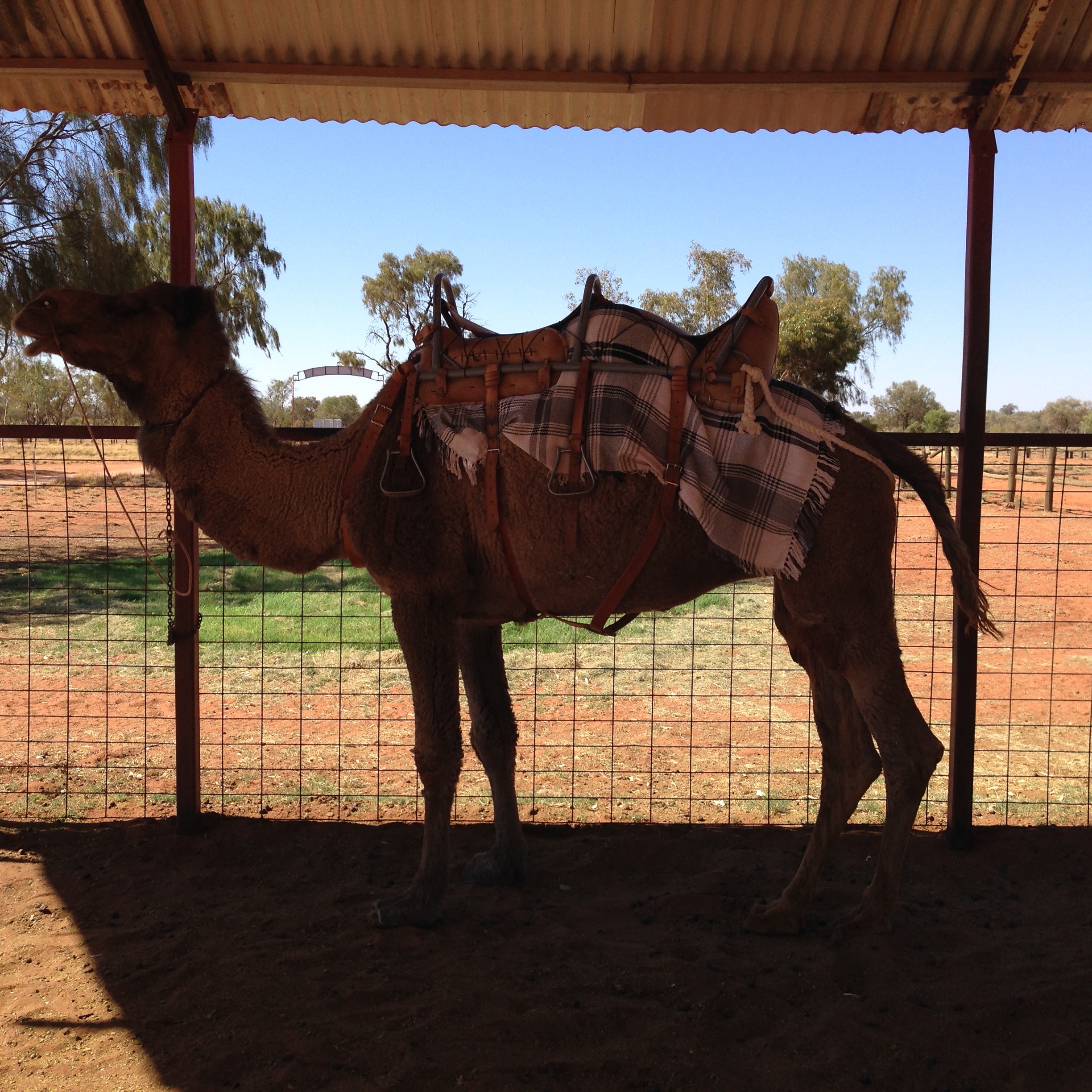
Camels, which are not native to Australia, were imported in the early days of development for projects such as building telegraph lines and railroads. When the projects were completed, the management ordered the camel drivers to take their animals into the outback and shoot them rather than bear the expense of shipping them back to Africa. Instead, the drivers released the camels, which survived quite well in the outback. As a result, Australia, today has tens of thousands of wild camels. This camel is domesticated and was available for riding at a roadside stop on the way to Uluru.
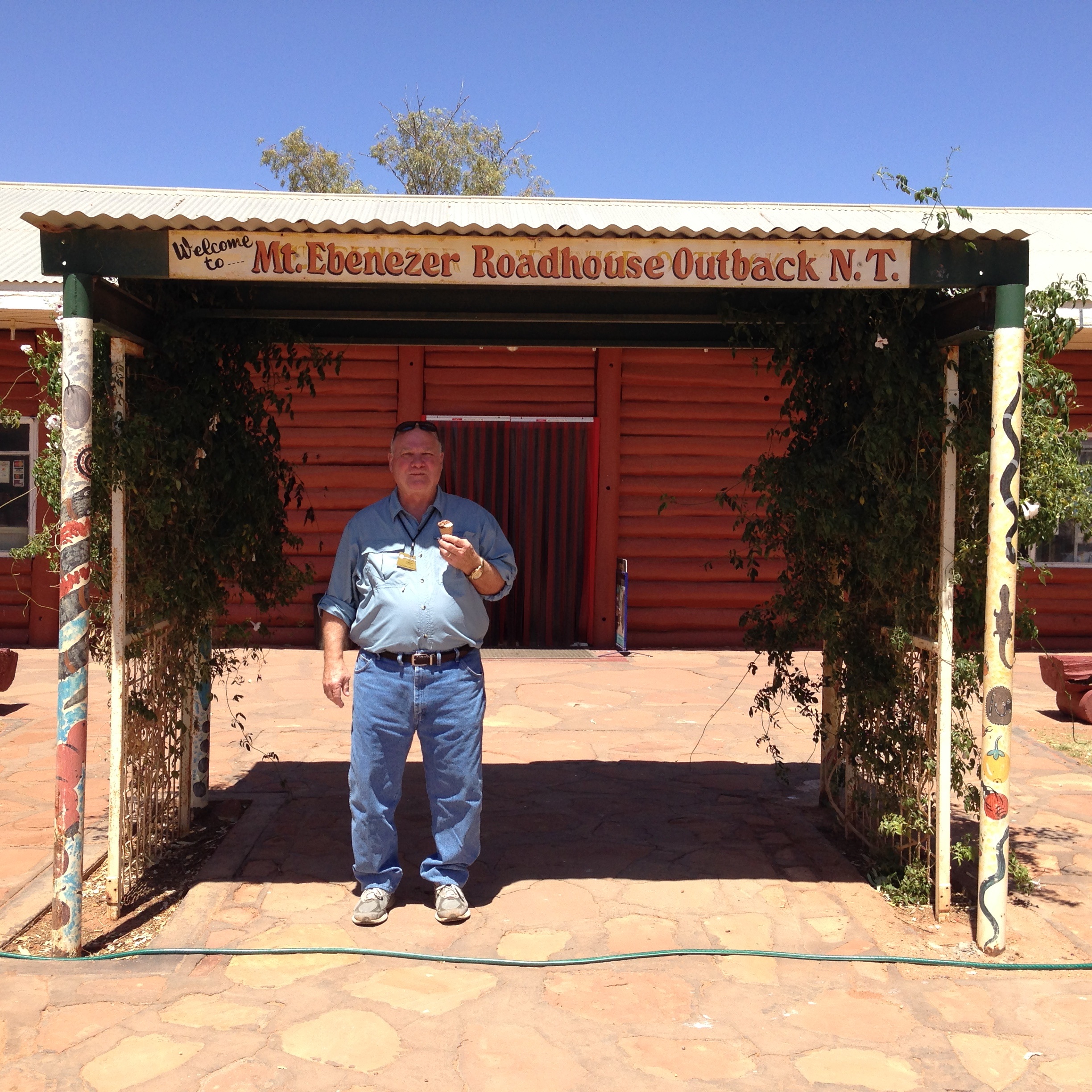
One of the great things about this trip was that we all dressed casually. This is Bob enjoying an ice cream cone at the Mt. Ebenezer Roadhouse. We stopped there for a picnic lunch on the way to Uluru. It was very windy and we had to use weights to hold down the table coverings. Inside, the Aussies were watching American football on satelite TV. We were also beginning to encounter the flies that are major pests in the outback.
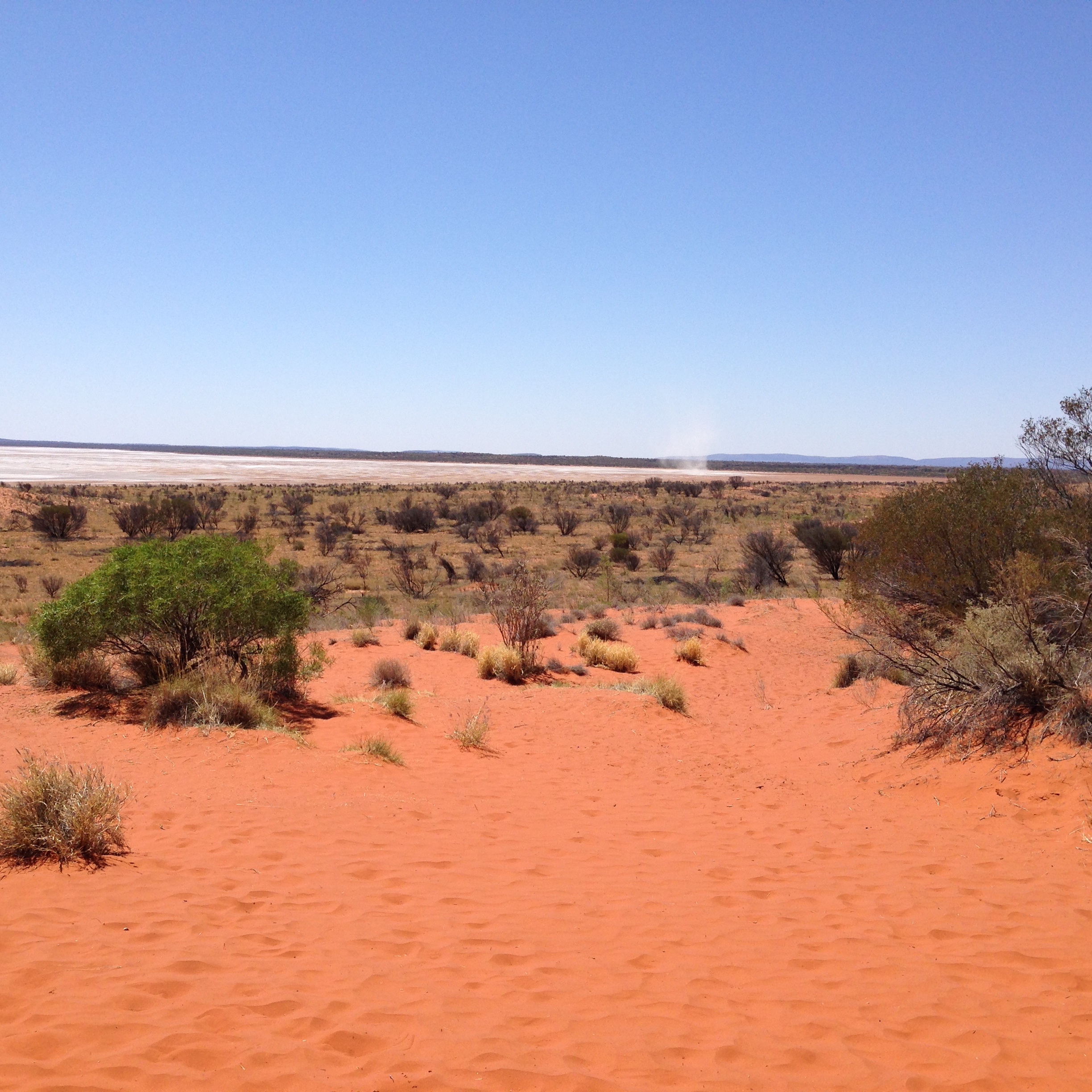
Our third stop on the way to Uluru was at a dry lakebed. Here you can begin to really see the bleakness of the outback. The aforementioned flies were very thick here. They invade your ears, eyes, nose and lips looking for moisture.
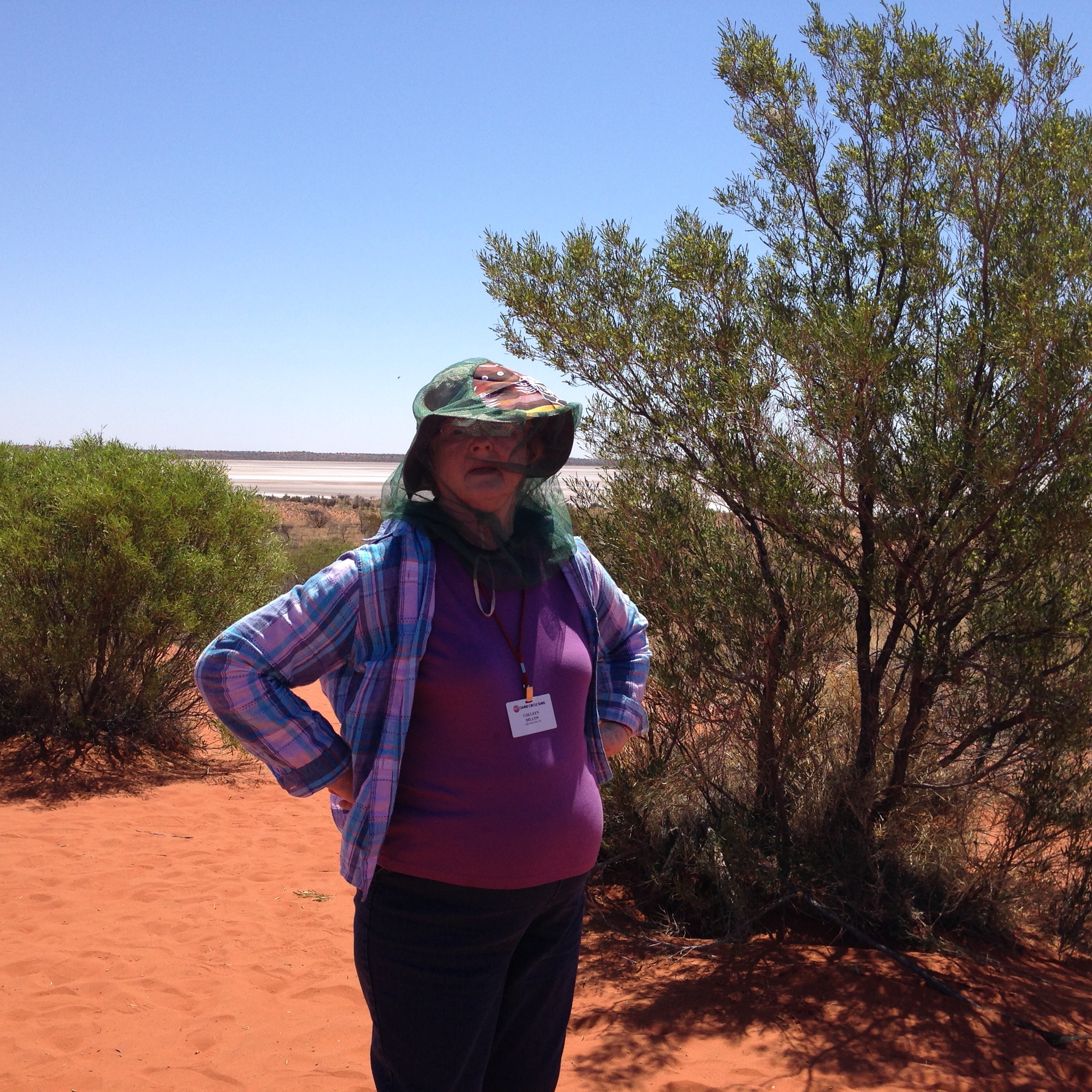
Here is Colleen sporting a flynet. We wore these whenever outdoors in this part of the outback. The flies would even follow us into the coach until filtered out by the ventilation system.
Uluru and Vicinity
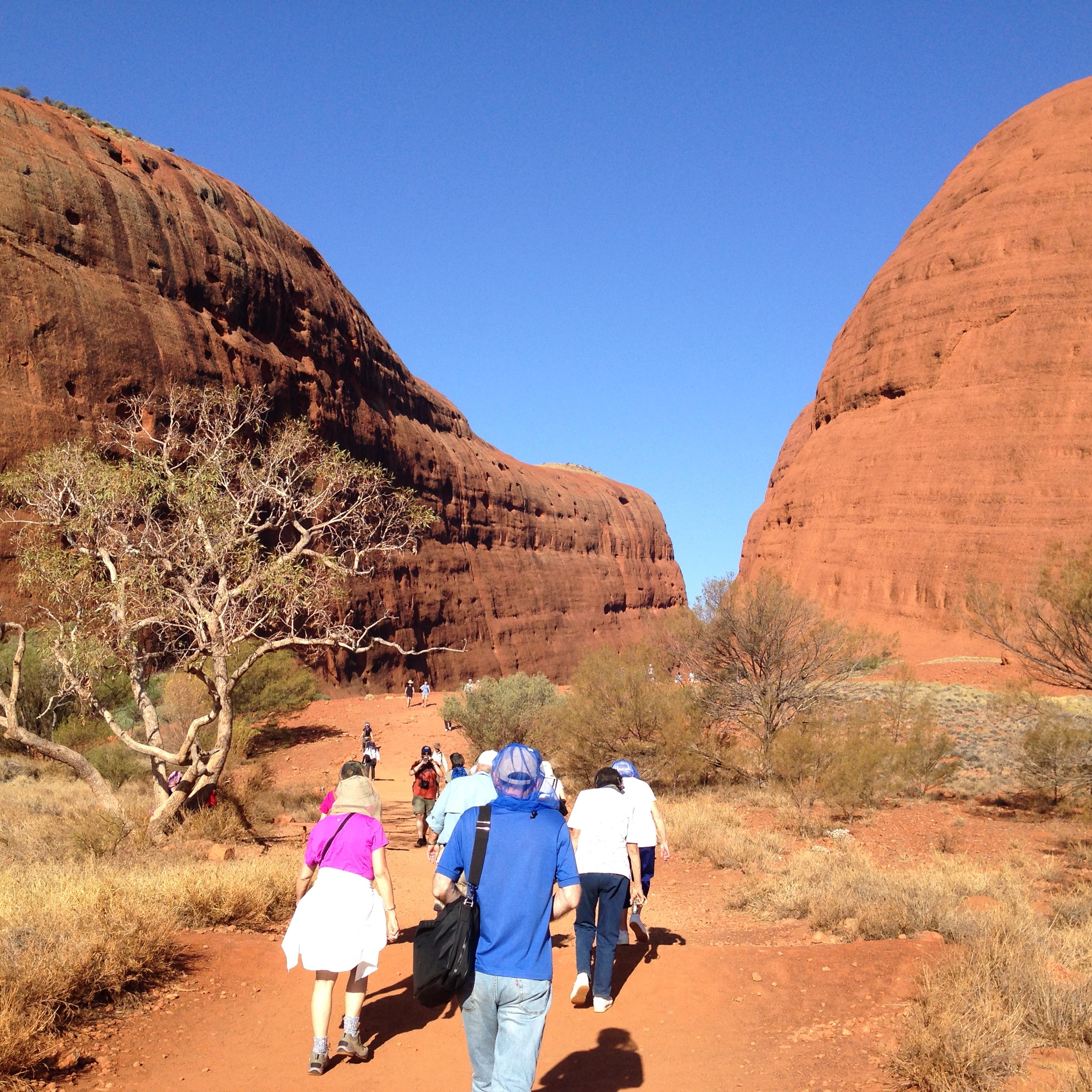
Here is a bunch of us treking up the slope to get a closer look at the domes. The Aboriginies consider some of these areas as sacred. They call these domes the 36 heads. There were many groups here besides ours. Notice that most are wearing flynets. This is not Uluru, yet. However, it is a nearby geological structure with almost equal significance.
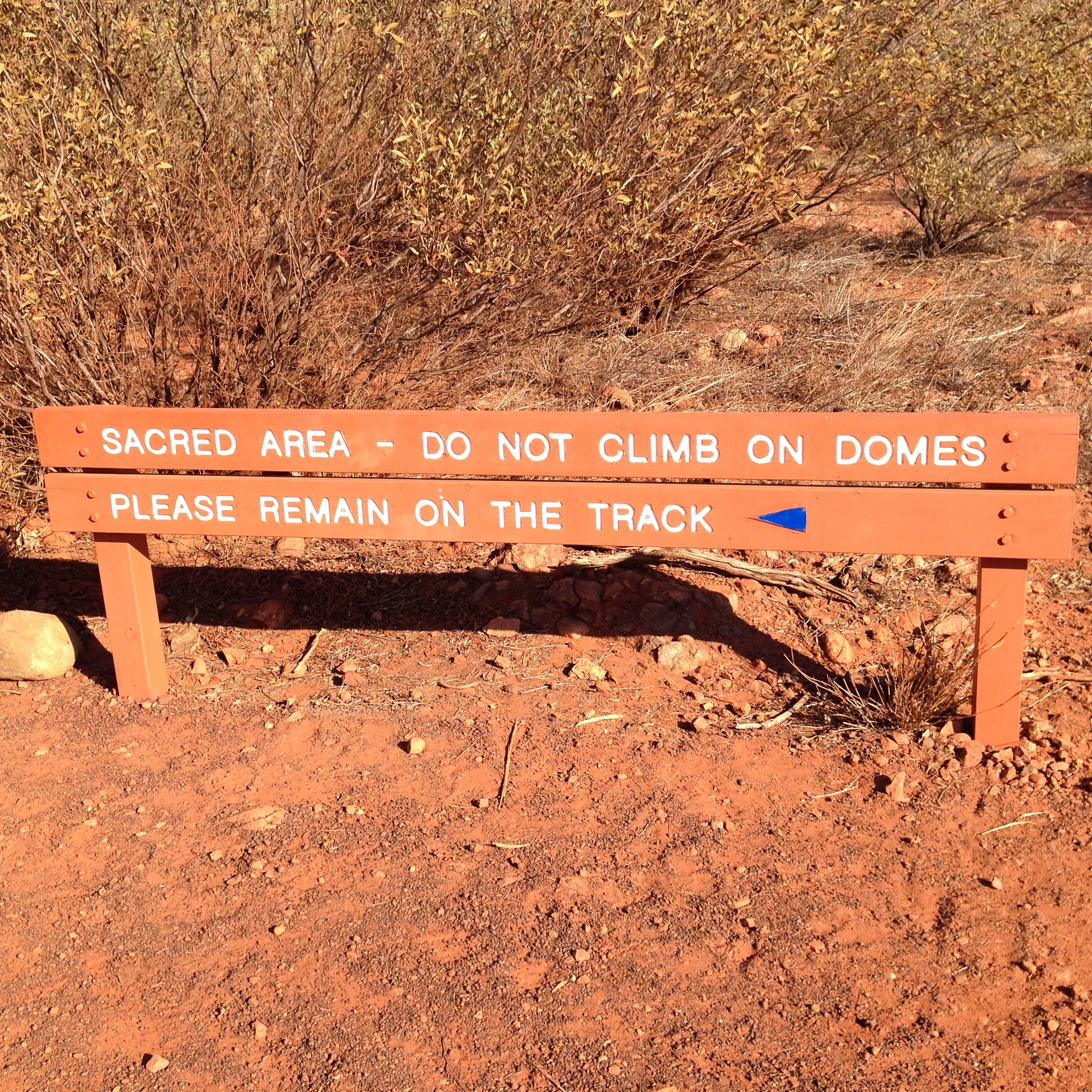
We did not cover the whole area, as we had limited time at this place. Our shoes were embedded with this red dust.
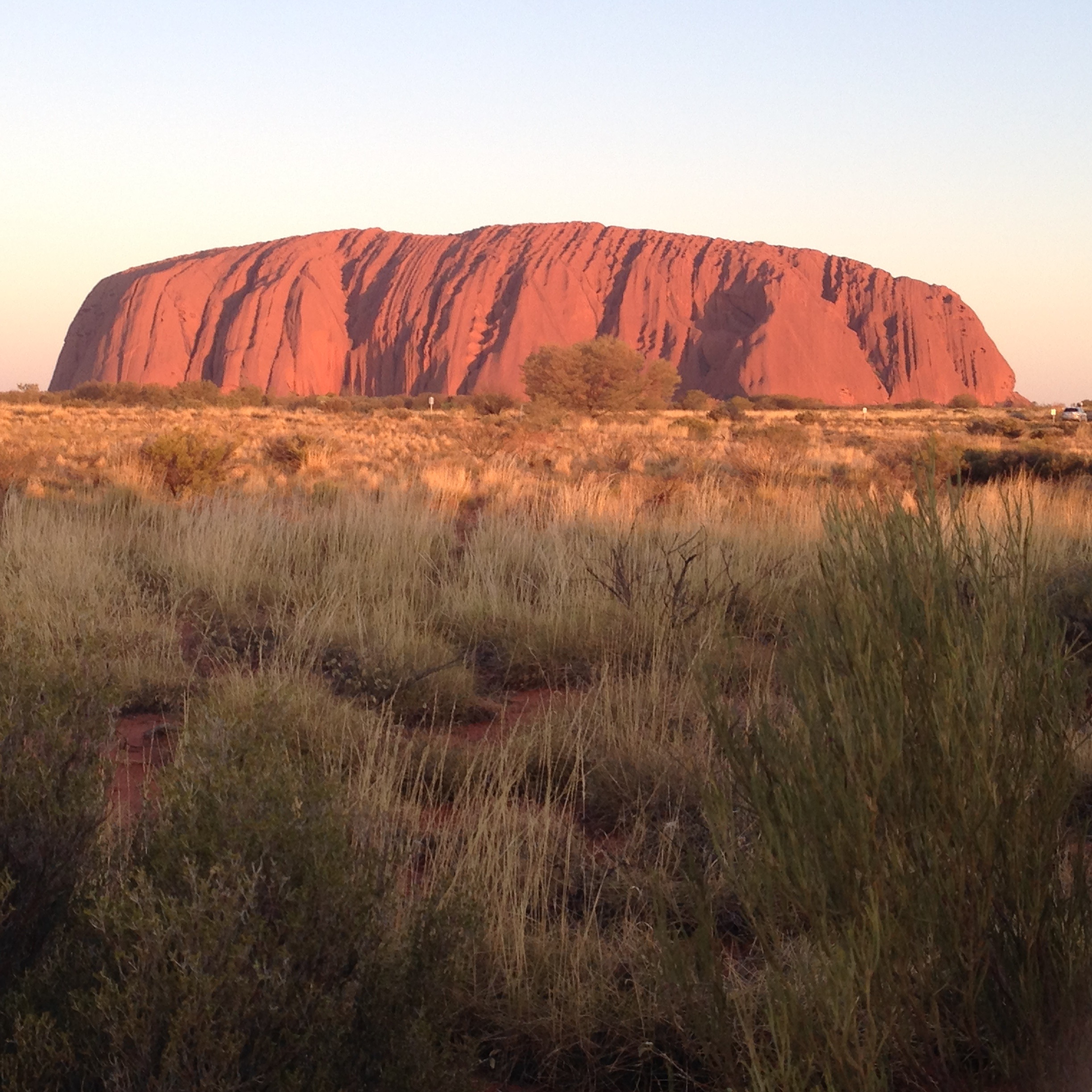
This is Uluru. Near sunset, we joined about 30 other groups to view Uluru change colors as the light faded at sunset. It was very nice. We had hor'dourves and wine. However, my smart cellphone camera compensated for the color changes, so they all look about the same. Here, we are in a parking lot about a mile away from the rock.
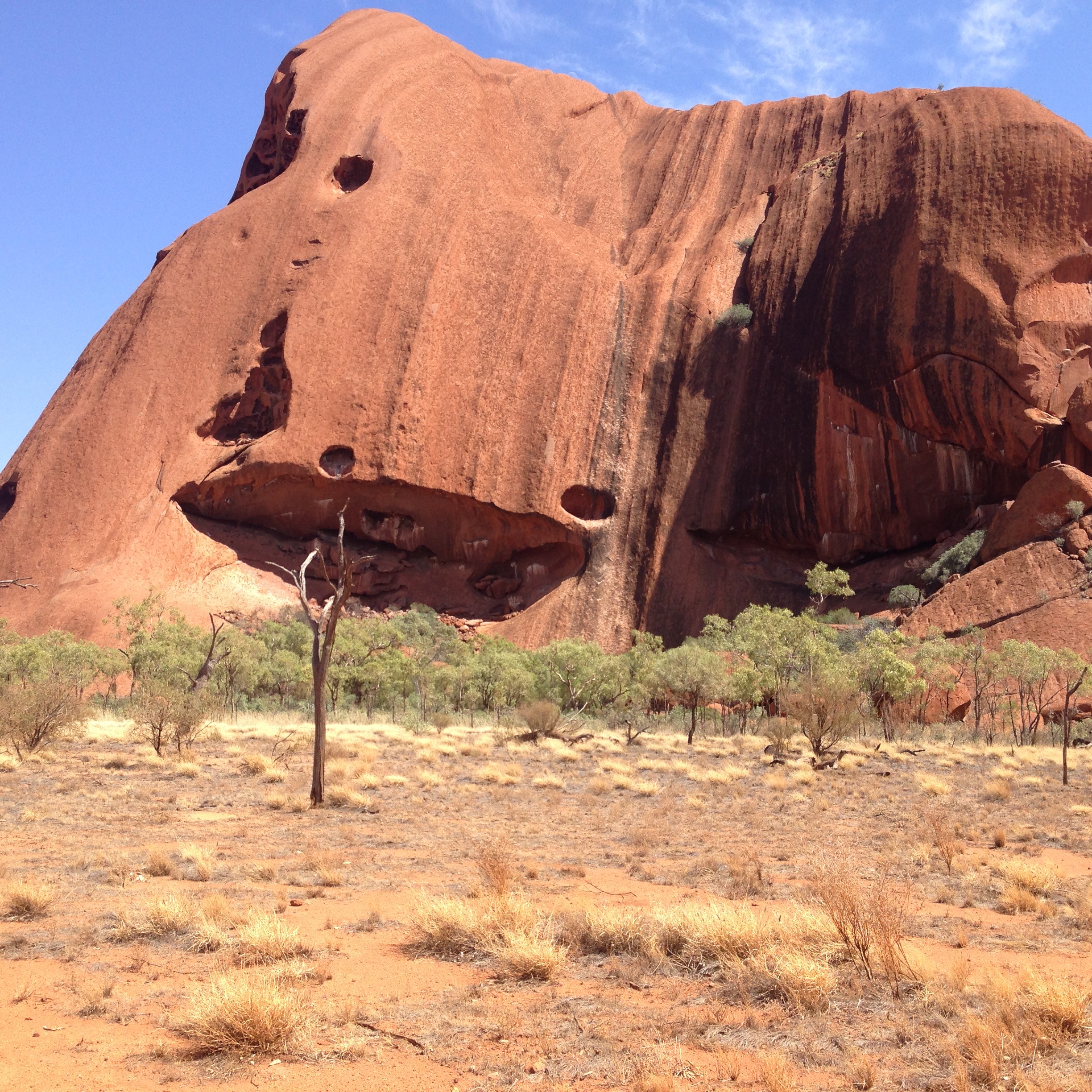
On October 5th, we went for a close-up tour of Uluru. Our guide was an Aborigine named Vincent. He explained a great deal of the history and folklore of the area.
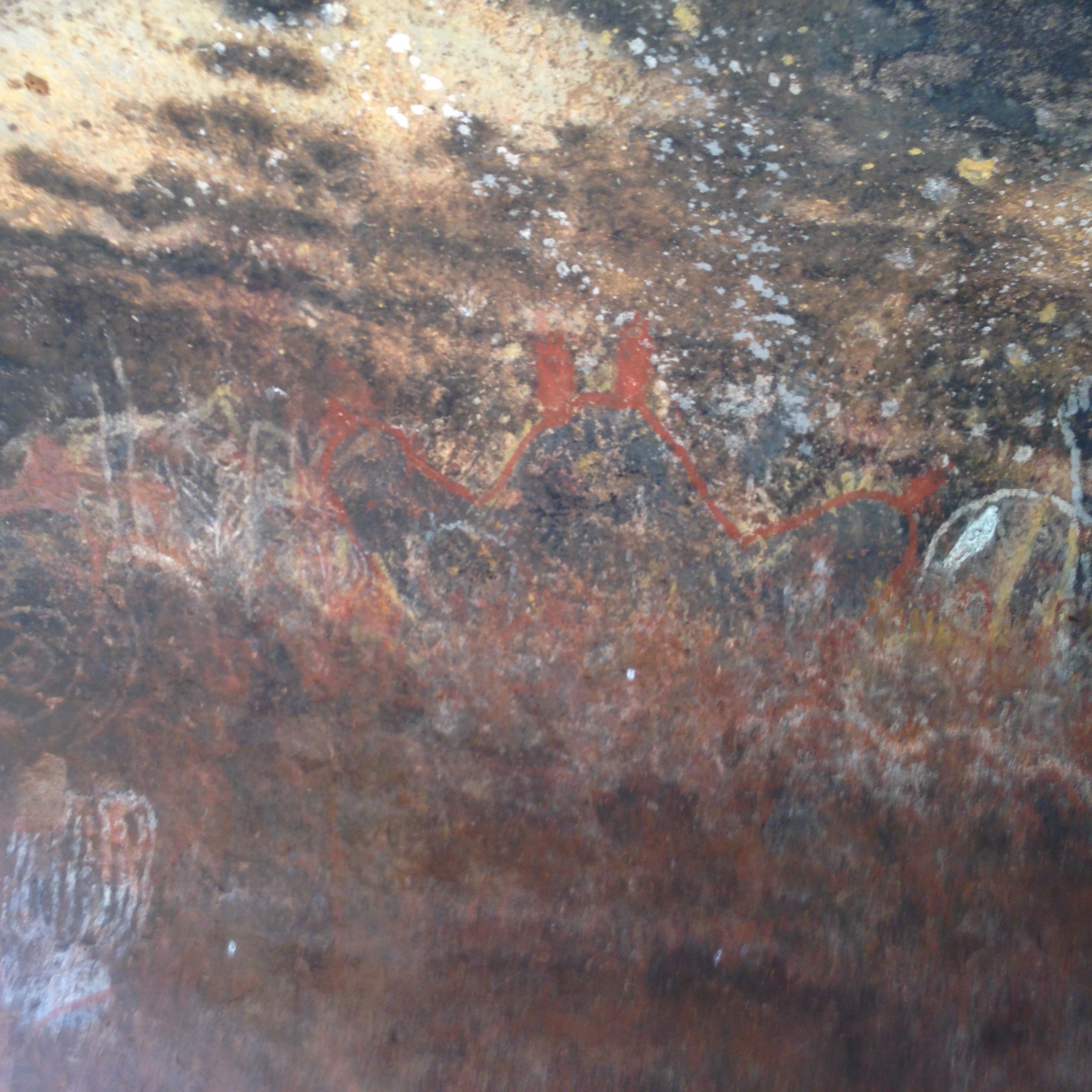
This is an example of the wall paintings that can be found in relatively sheltered areas. These are close to 20,000 years old.
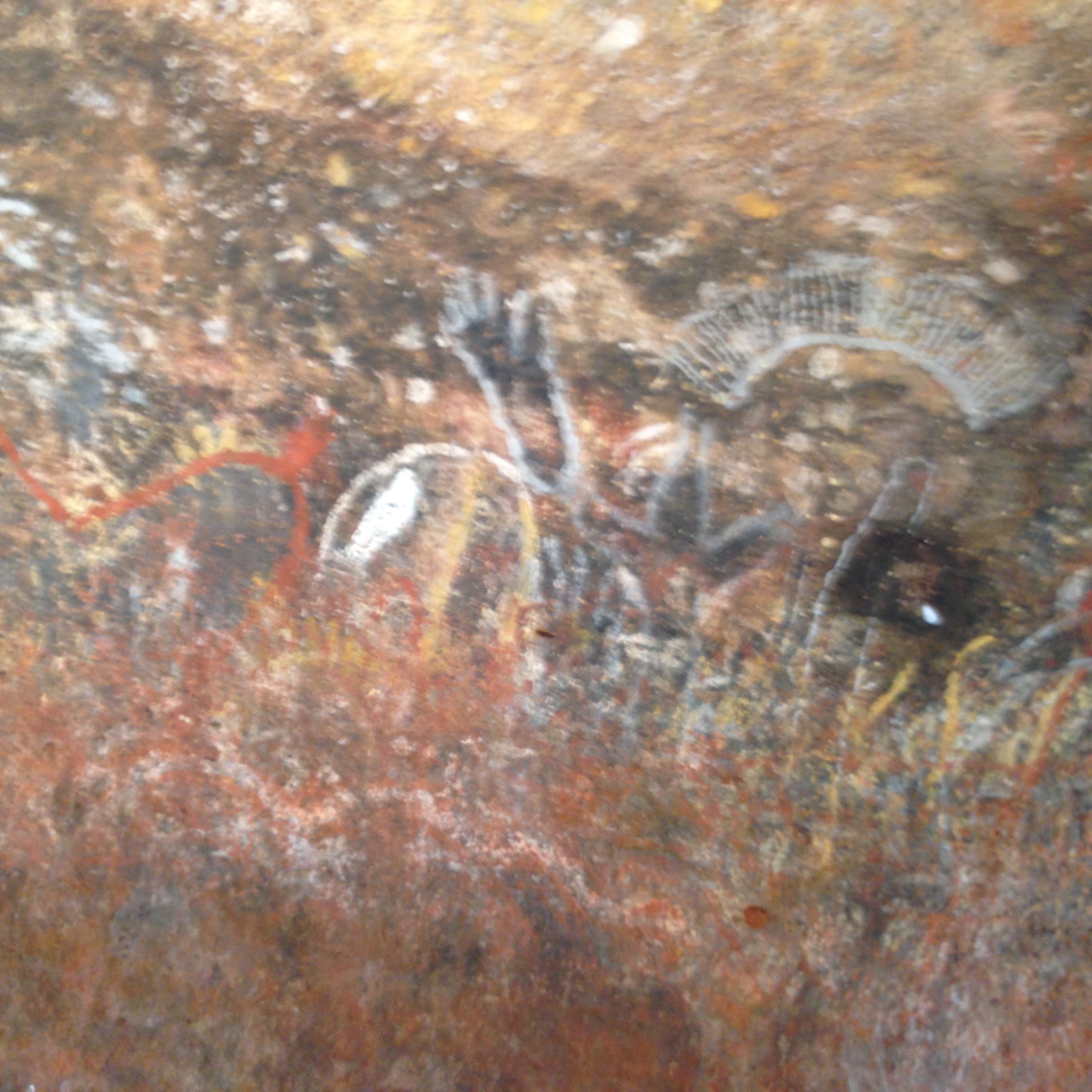
This is another nearby wall painting.
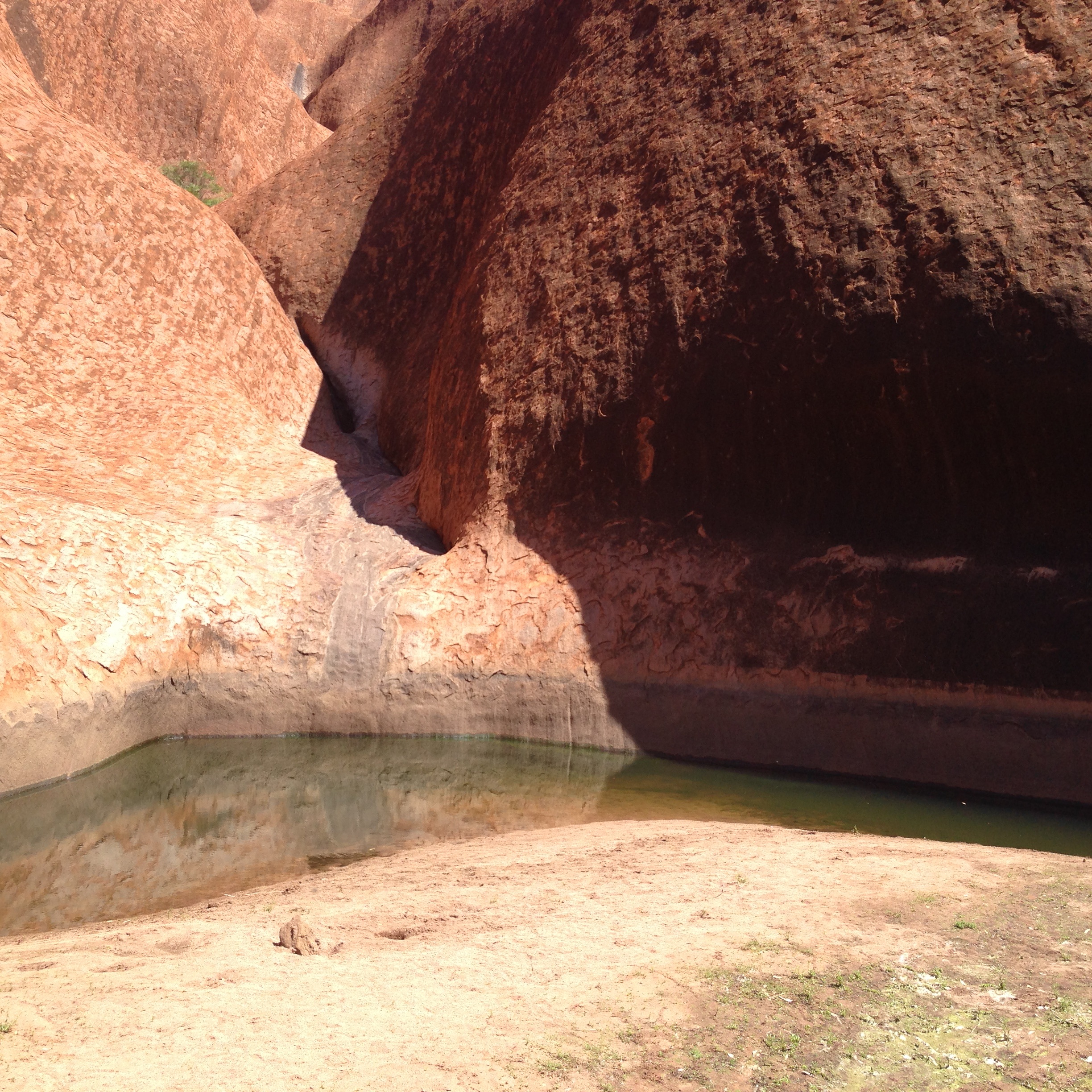
Although we are in the outback, there are water pools around Uluru. This explains how the Aborigines could survive here.
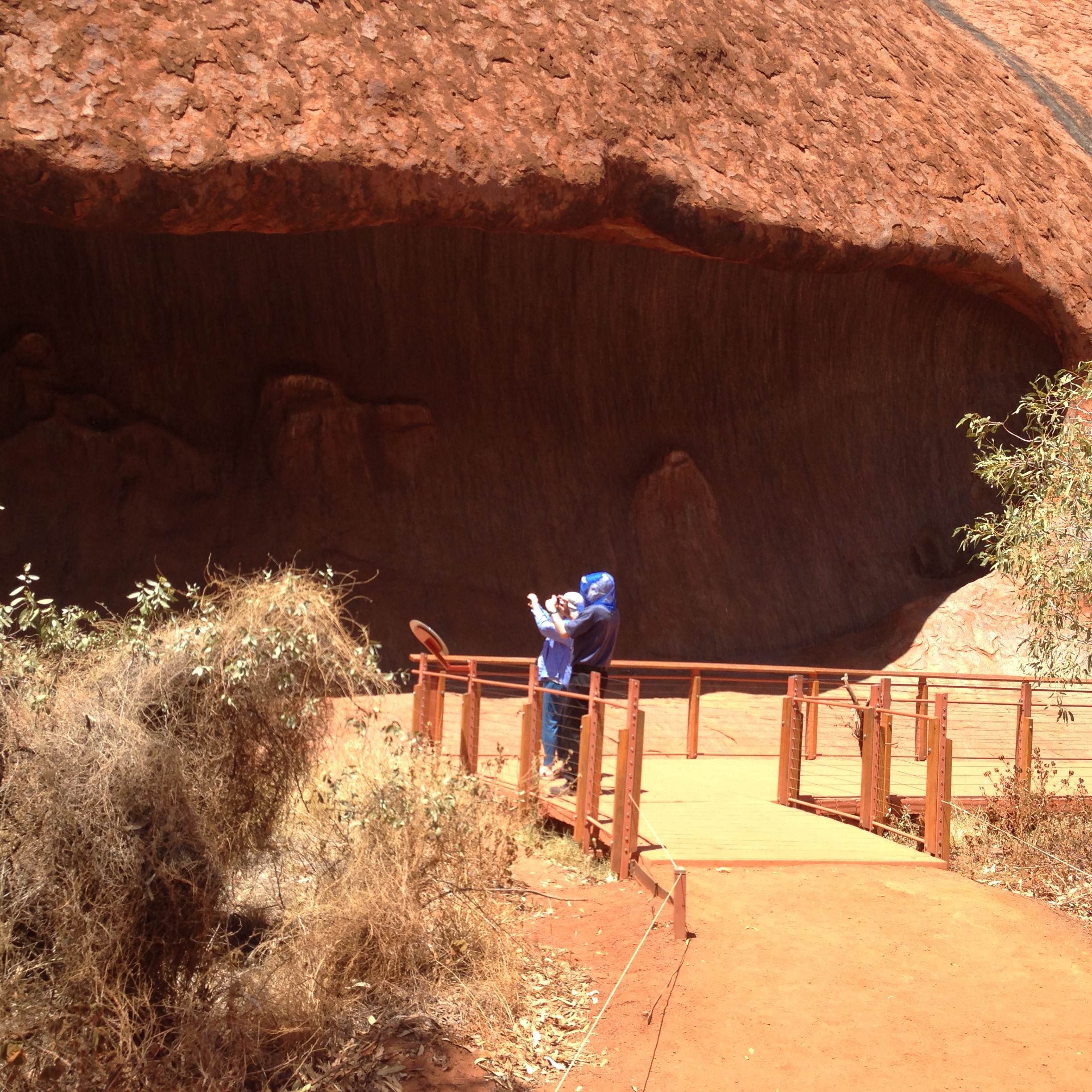
This is an overhang which sheltered a group of Aborigines.
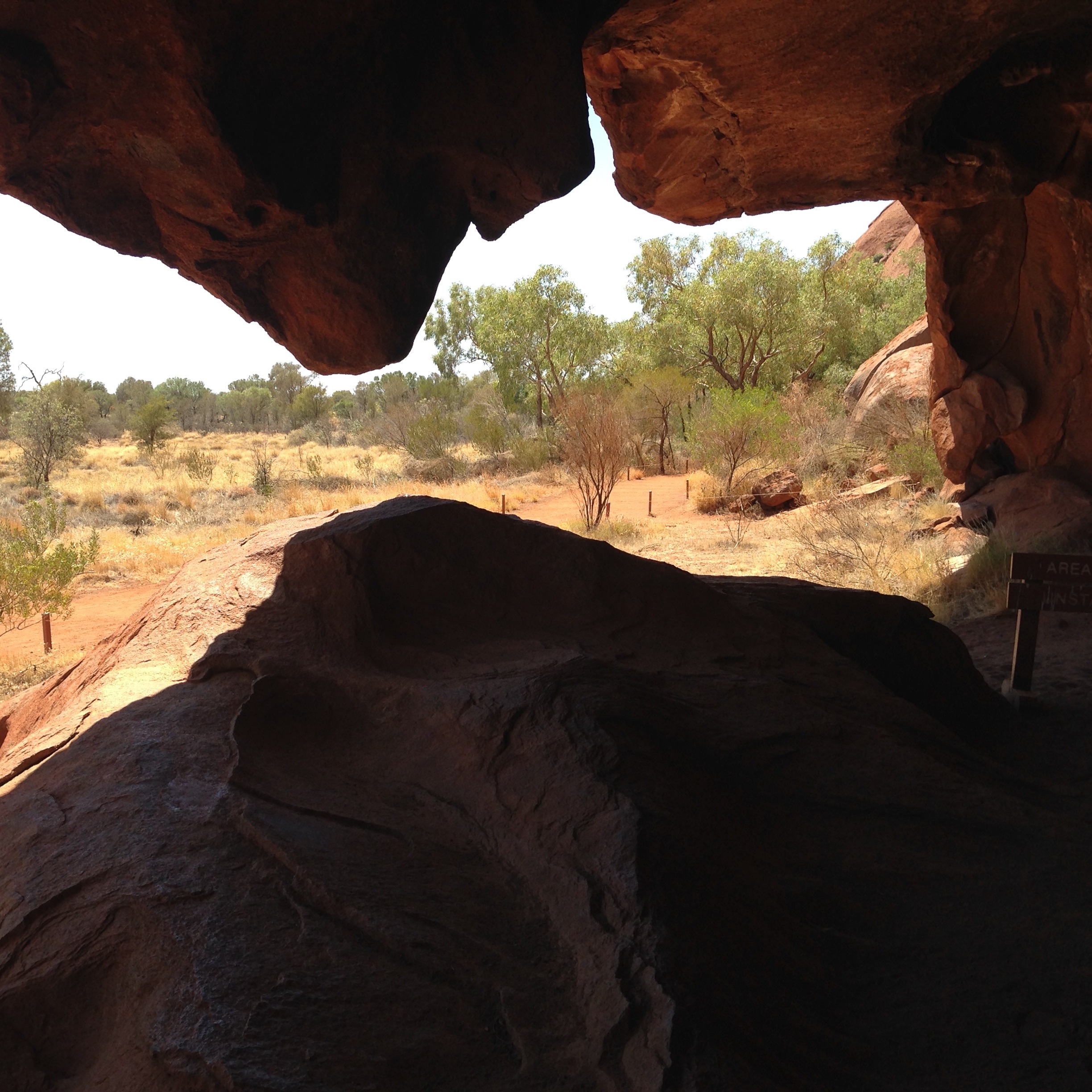
From inside, we can see that there was primitive shelter.
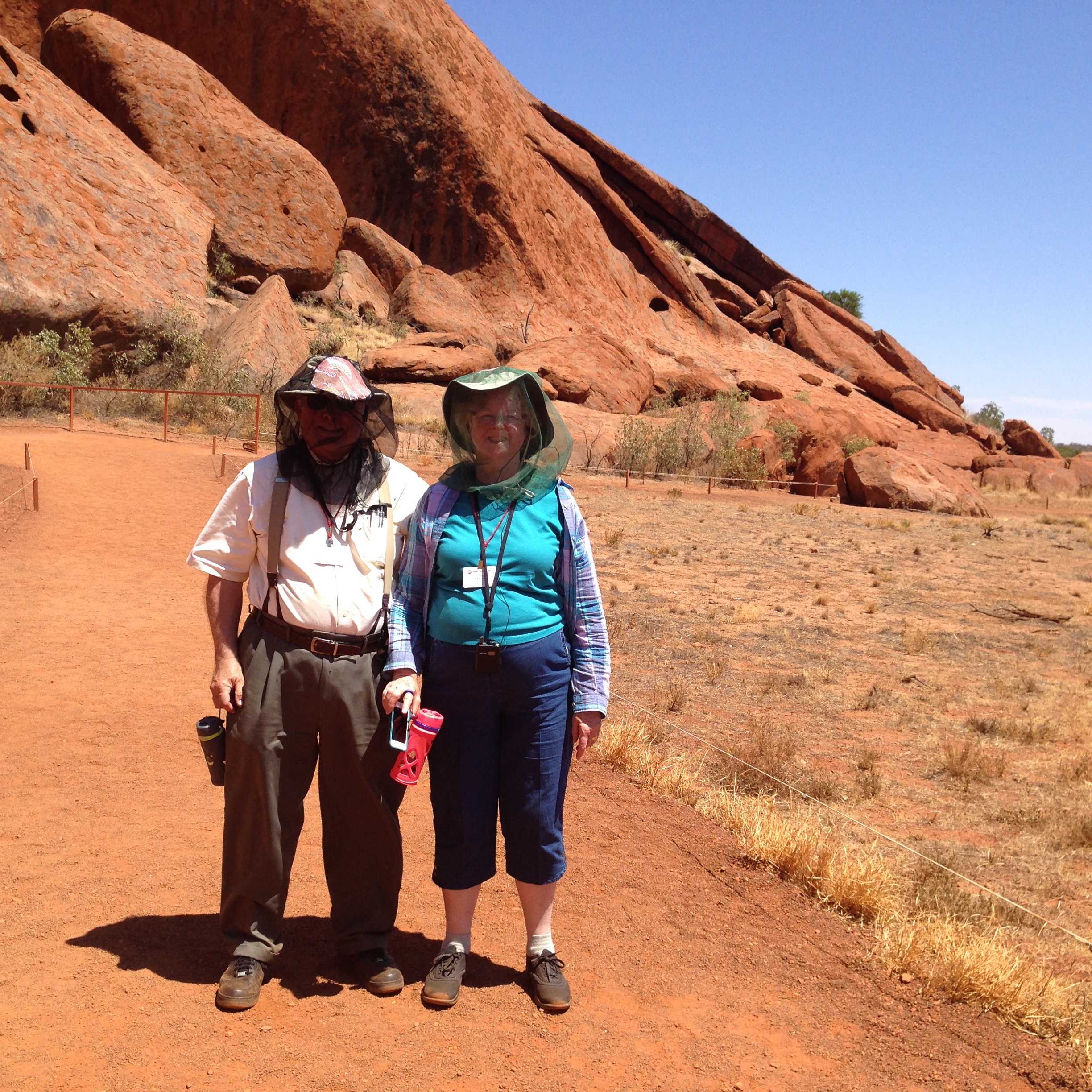
Here we are at the end of our Uluru Walkabout. Notice the flynets, water bottles and red dust on our shoes. The red dust on Colleen's shoes was enough to trigger the metal detectors at the airport when we boarded the flight to Cairnes.
Cairnes
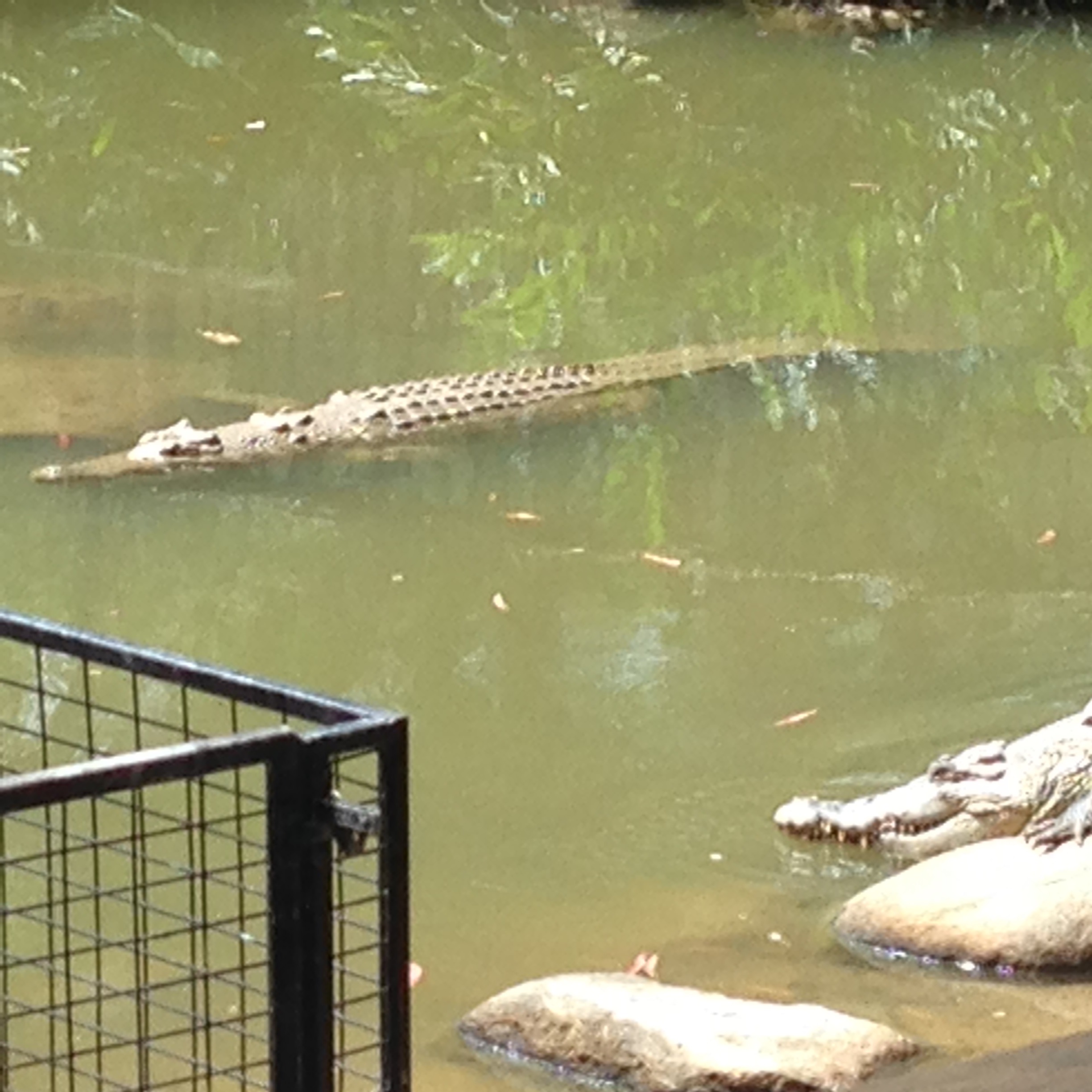
On October 7th, we were in Cairnes, a vibrant Eastern coastal city. We visited a crocodile farm where they breed and raise crocs for their meat and hides.
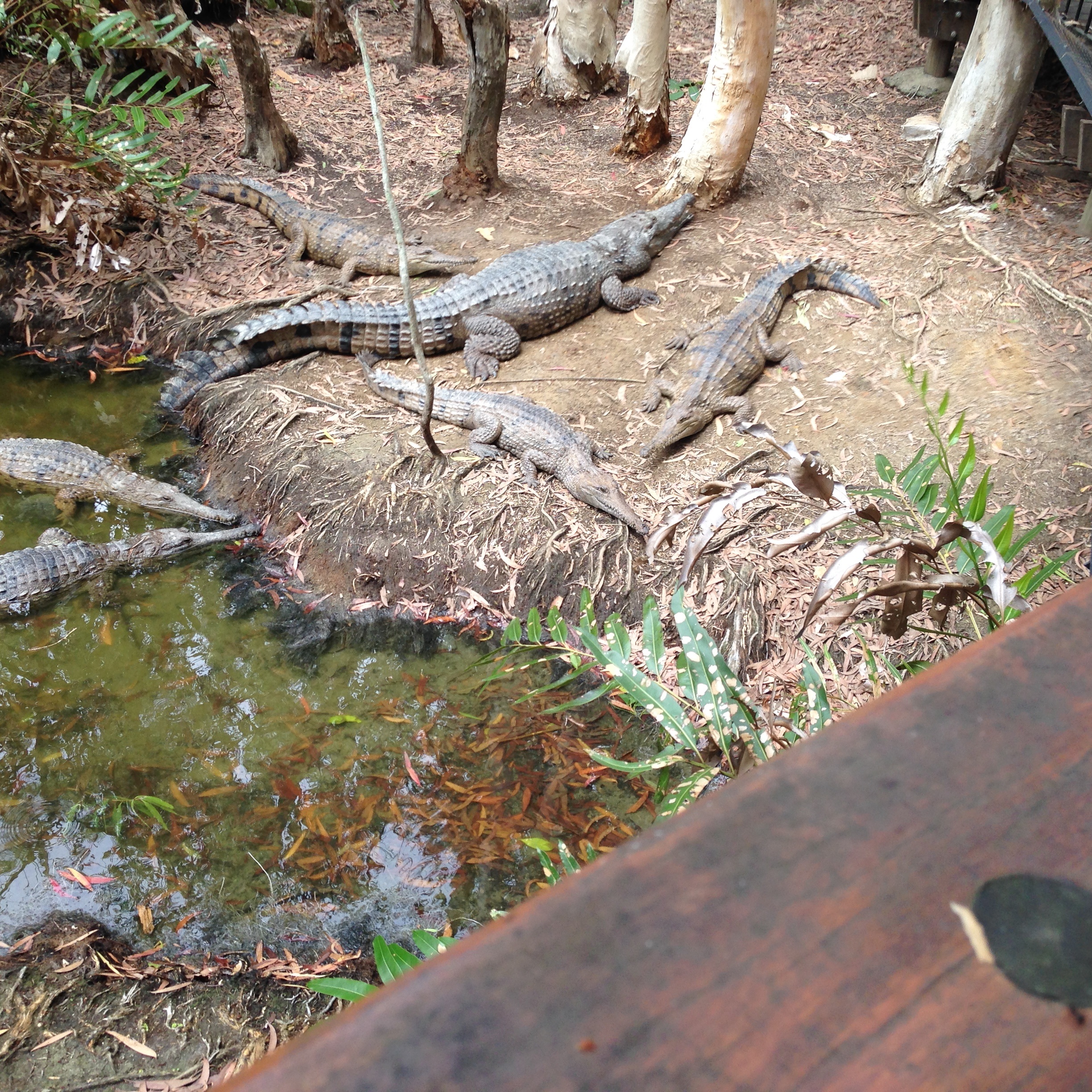
Here are some more of them.
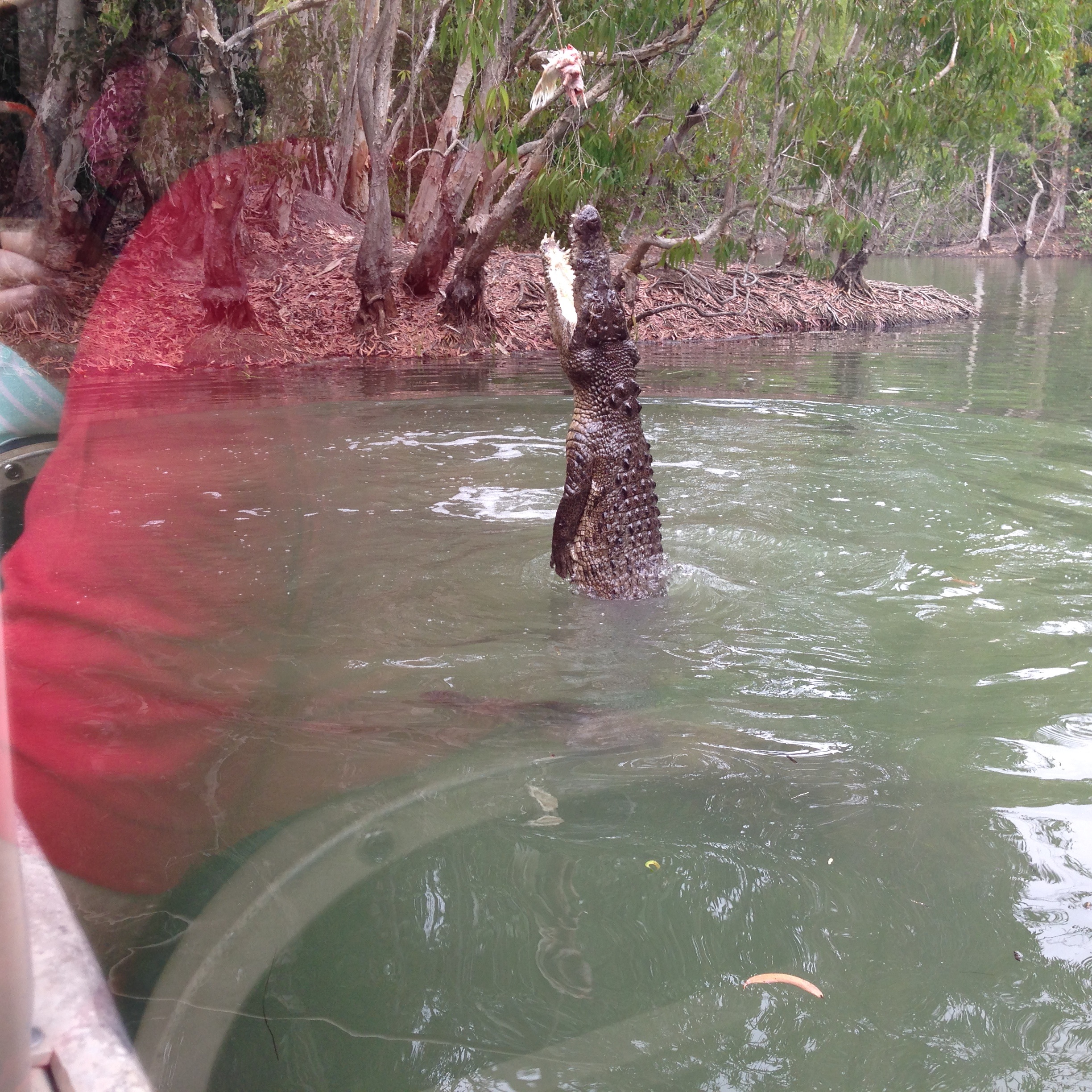
On a boat ride through the croc farm, our guide teased the residents by suspending a partial chicken carcass on a string tied to a pole. He would jerk it away to make the crocs jump for it. The photo is flawed because it was taken through a plastic window and there are obvious reflections. The ferocity of the hungry crocs is evident, however.
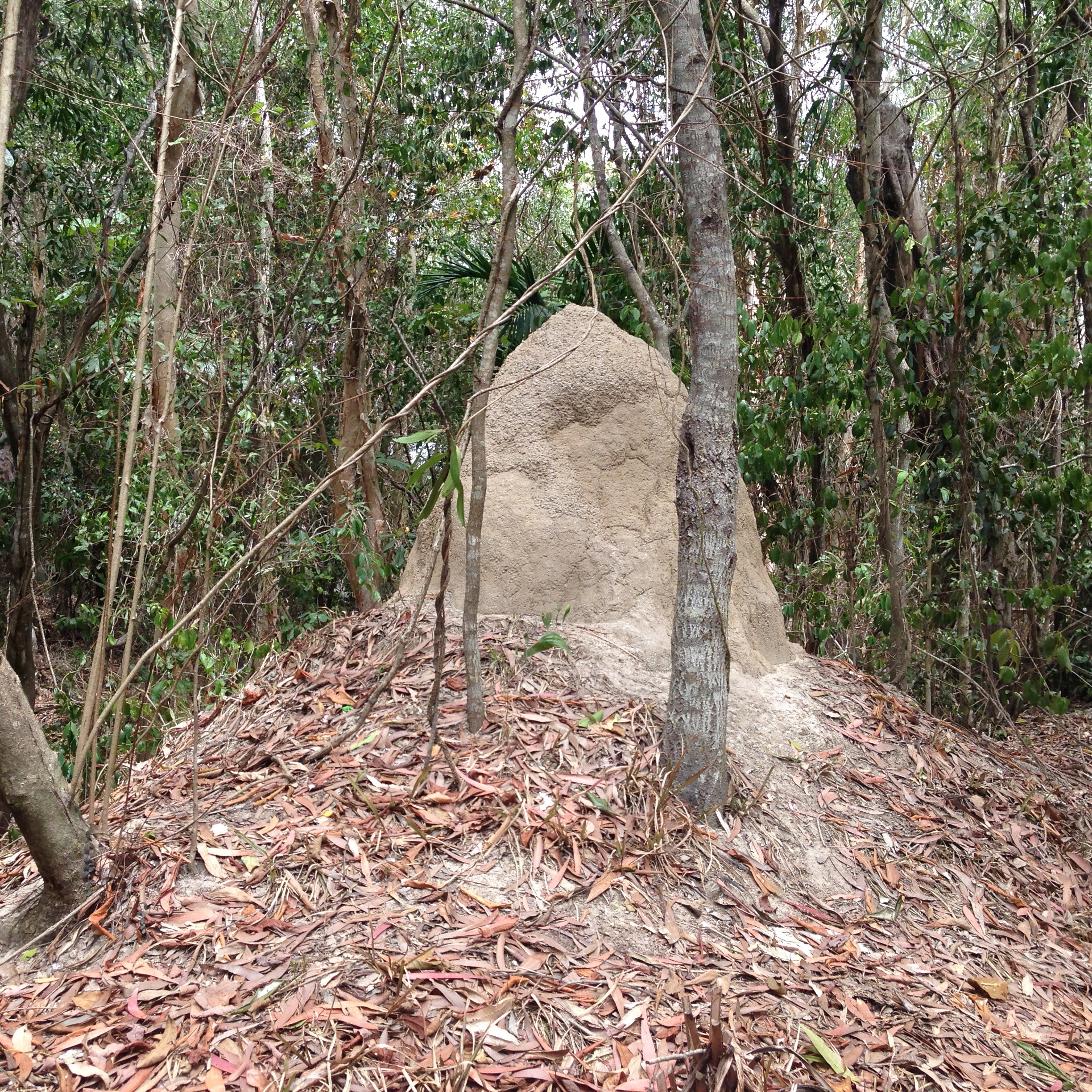
On the boat ride through the crocodile farm we passed a termite mound. These are common in Australia. We also saw them in the outback.
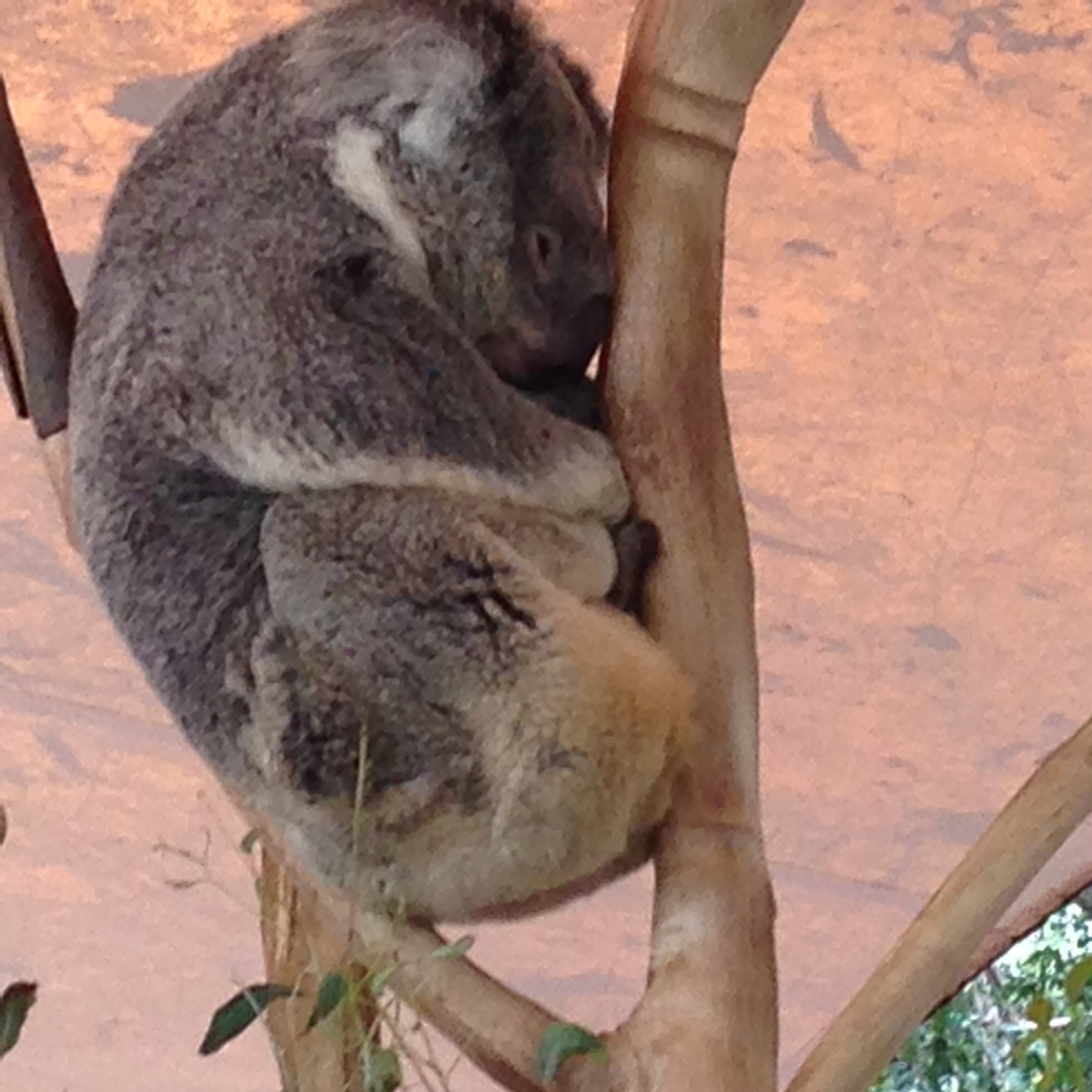
They also had other animals at the croc farm. This is a sleeping female koala. Koalas spend most of their lives sleeping.
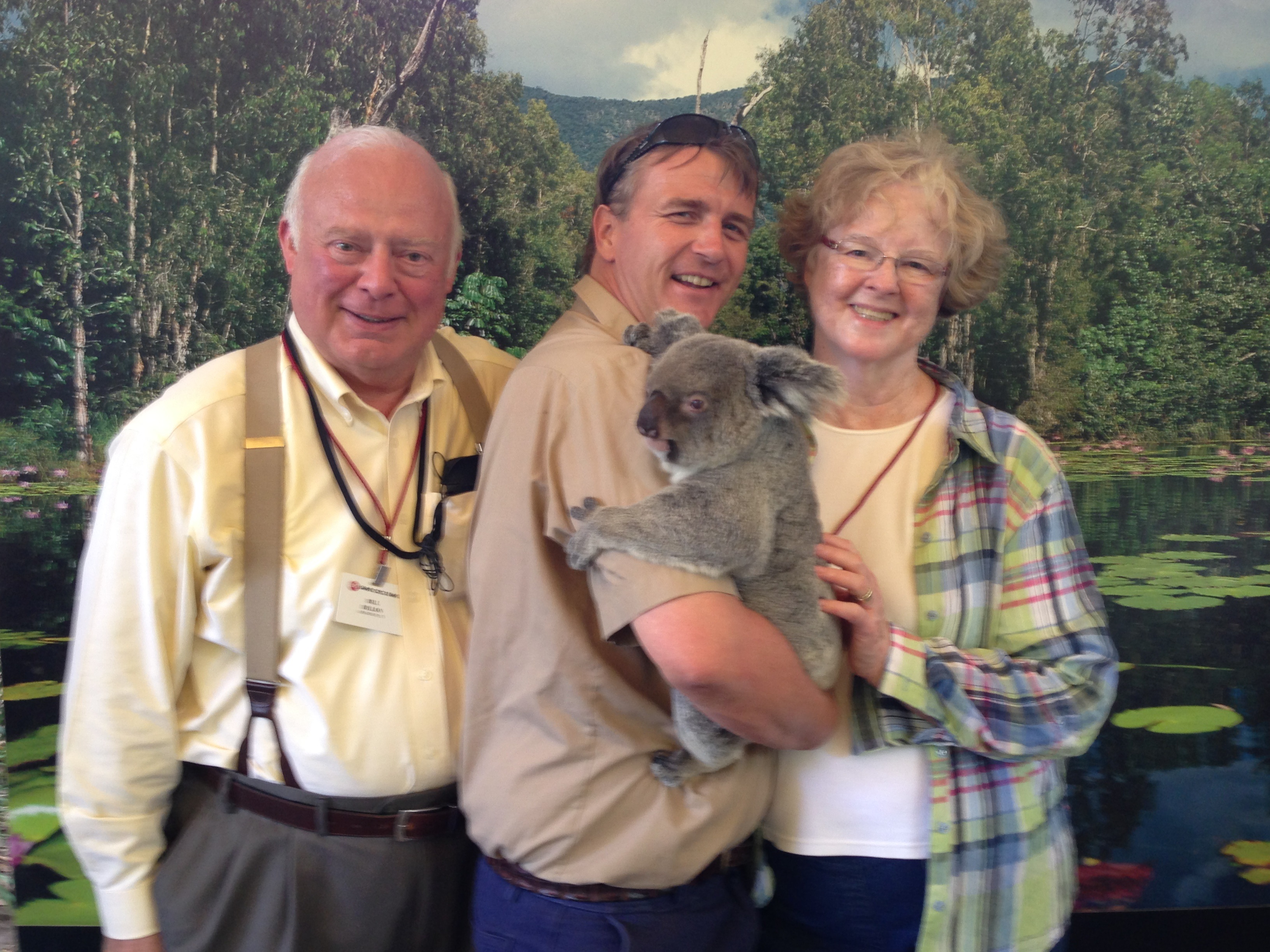
Later, we returned and our guide posed with us to get the koala's picture. It was not safe for us to hold the koala. They are sensitive and crabby - especially when awakened from a nap.
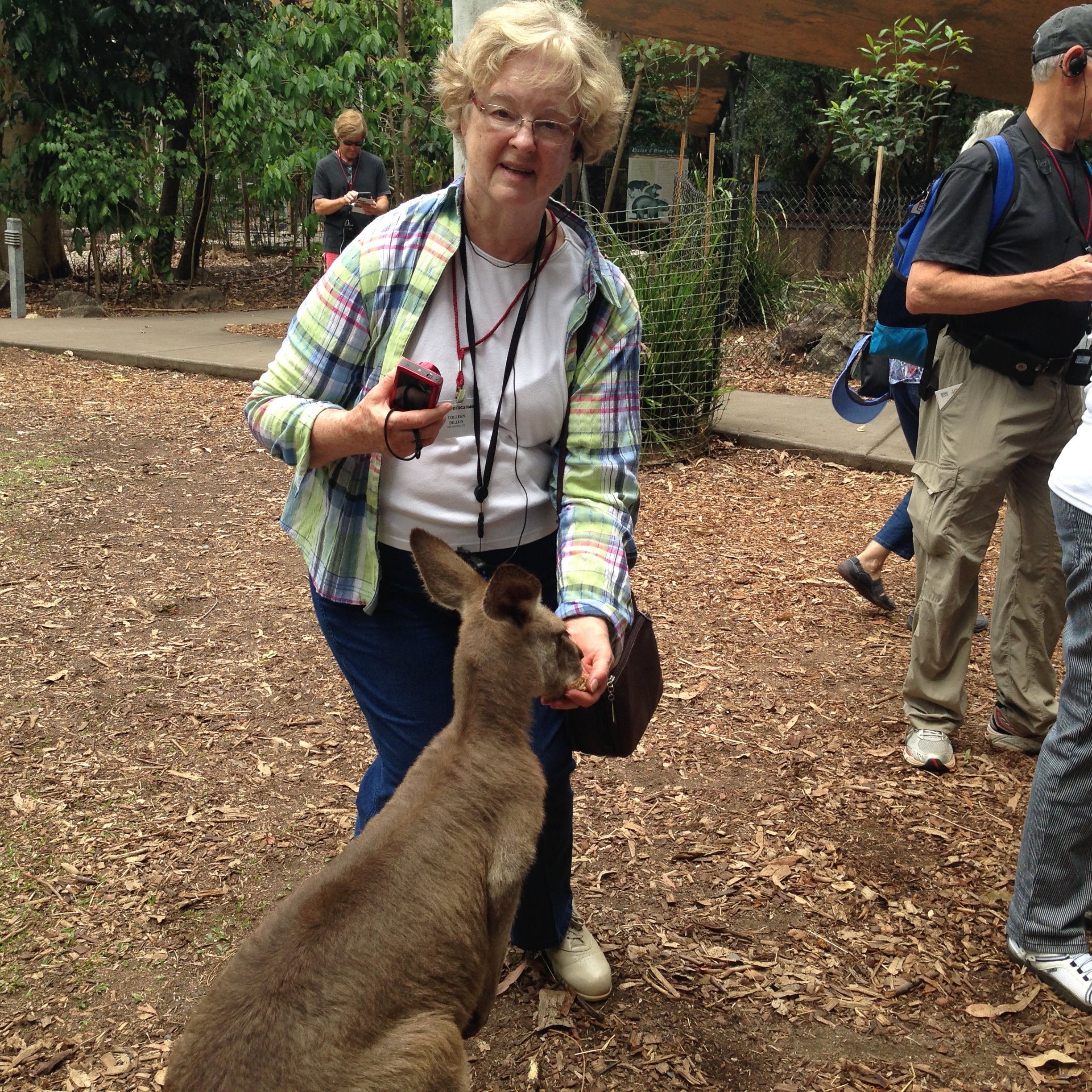
They also had wallaby's at the croc farm. Here is Colleen feeding one of them.
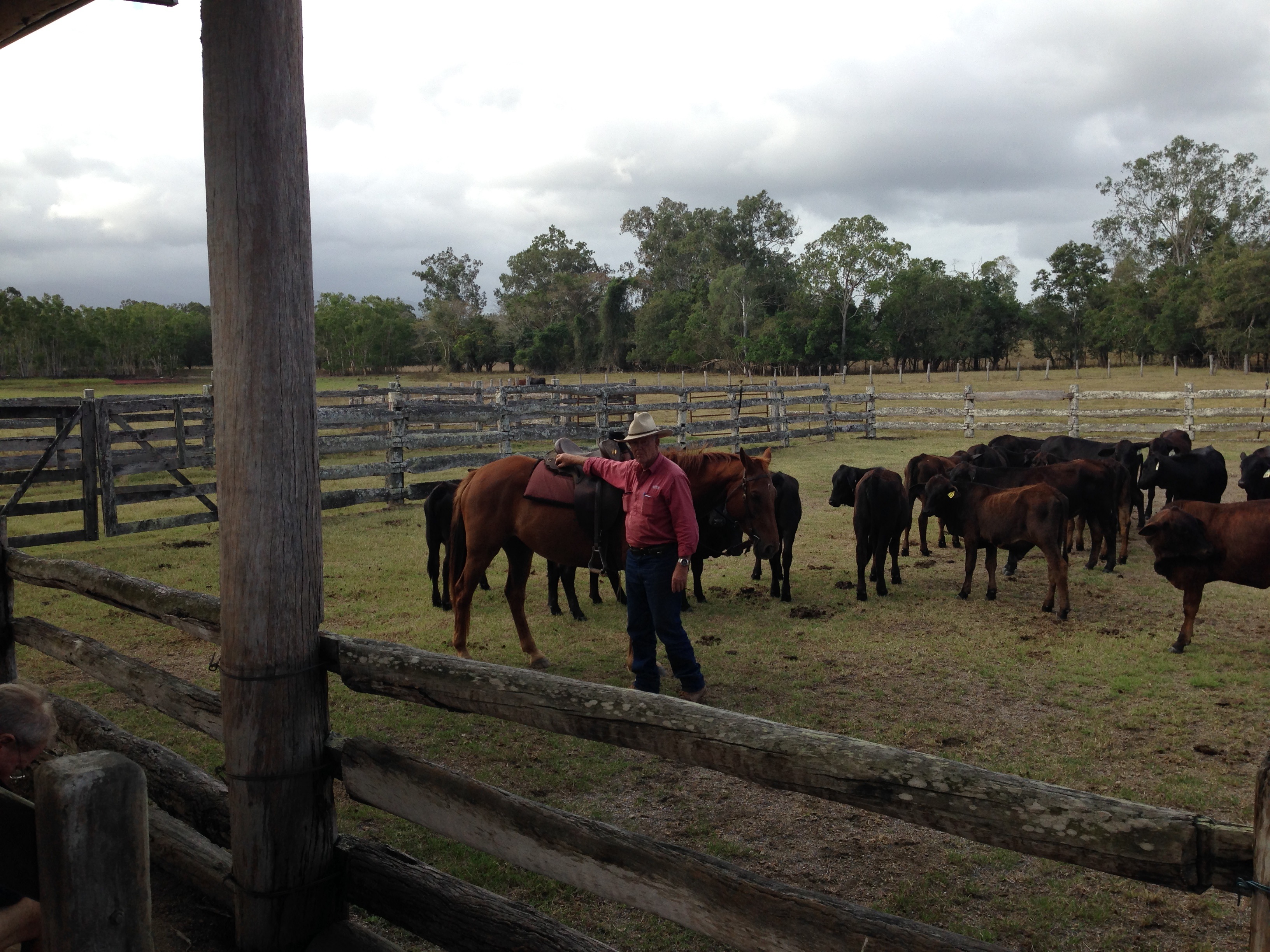
On the afternoon of October 7th, we also visited a cattle station. The rancher gave us a very good description of the beef industry and its history in Australia.
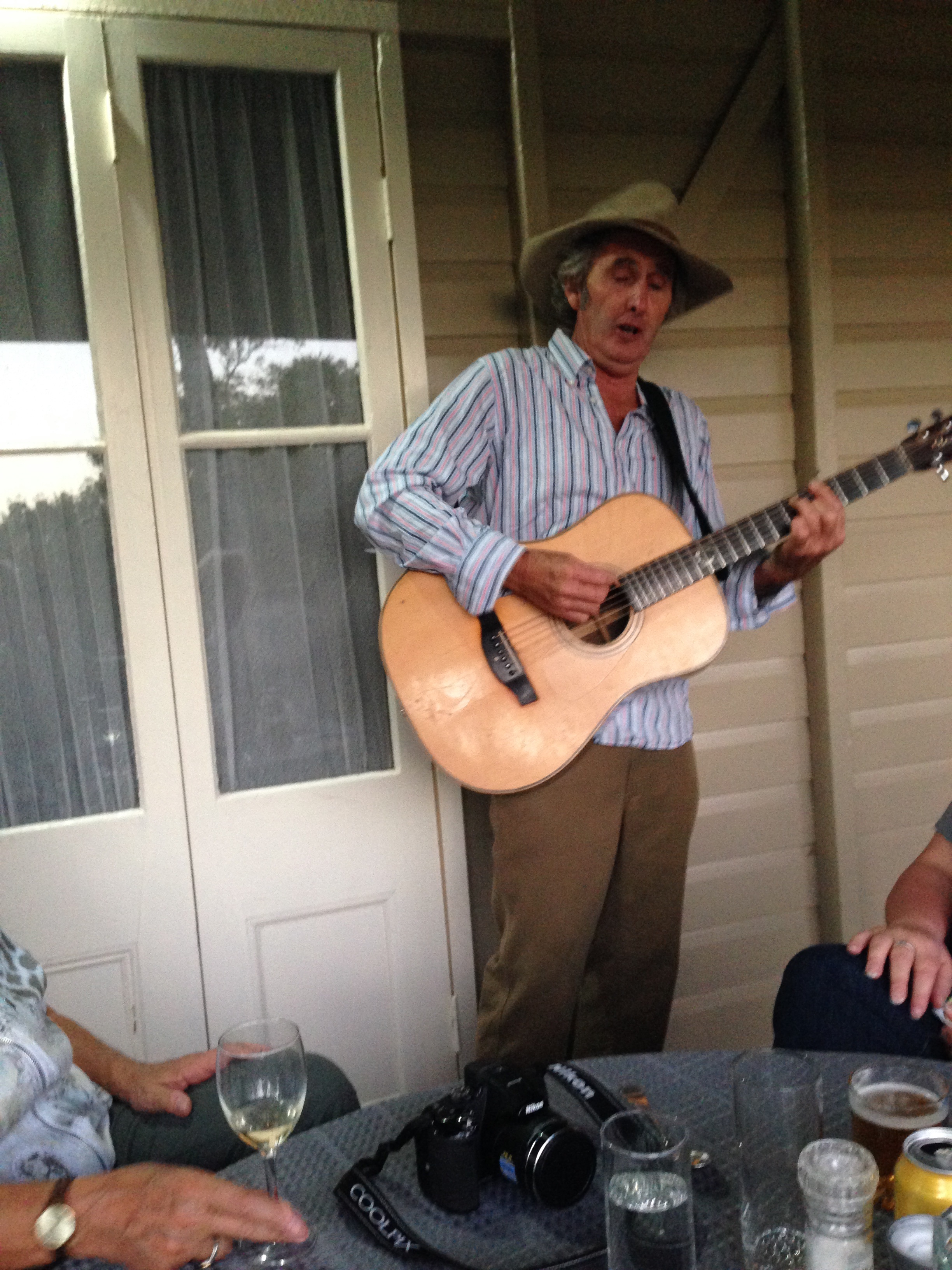
After the demonstration, we were treated to a fine dinner and entertainment. They has us singing "Waltzing Matilda" after we got a full explanation of the meaning of the Aussie terminology. A vibrant and independent culture, indeed!
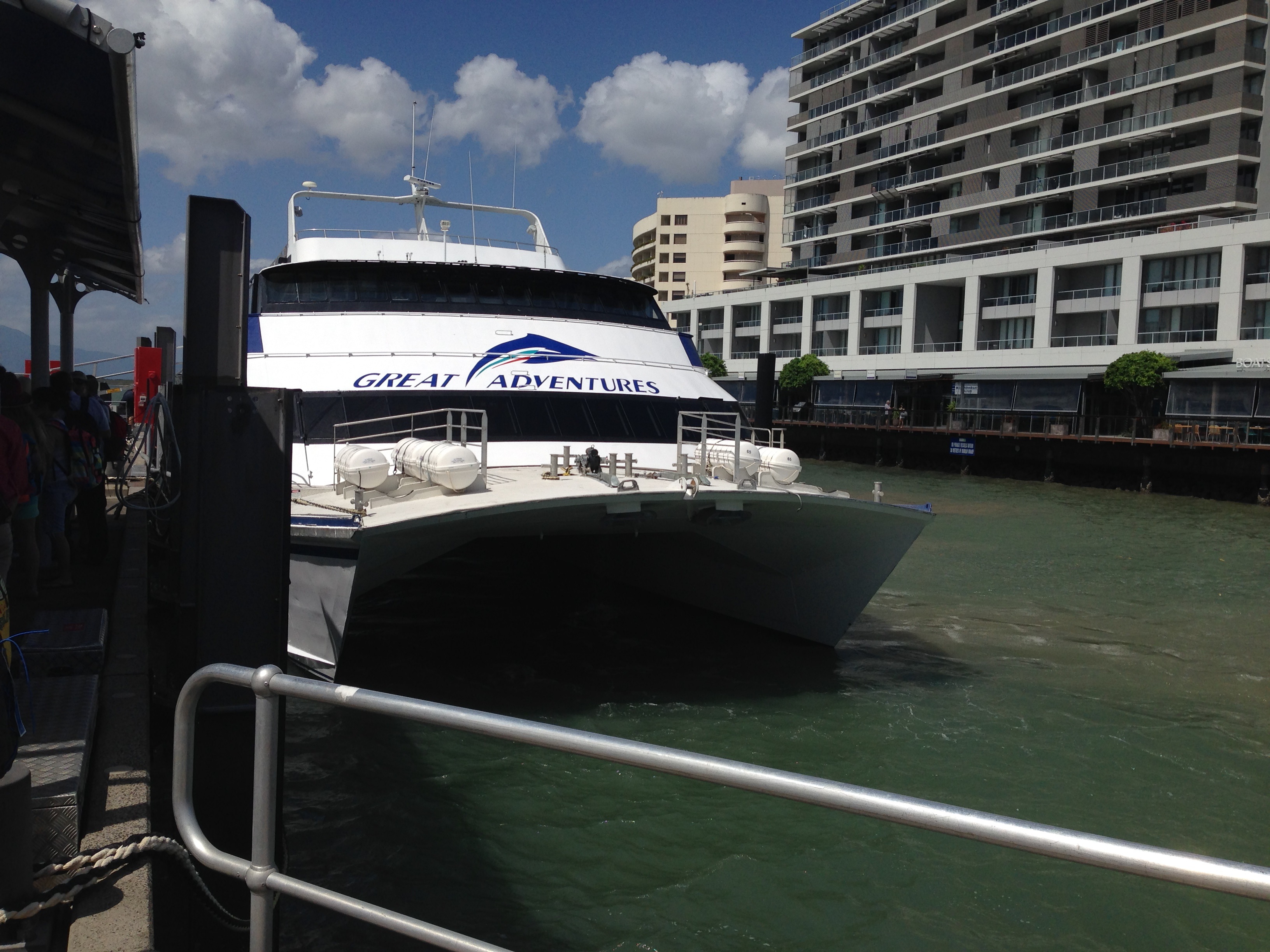
On October 8th, we took an excursion to see the Great Barrier Reef. Shown above is the boat we rode. It was a slightly rough ride and Colleen had a mild case of mal de mer. I was lucky and the ginger tablets worked for me. Once we arrived, we disembarked onto a large floating platform, firmly anchored to the shallow seabed. It was completely stable. There was even a nearby helicopter pad for VIP's and/or emergencies.
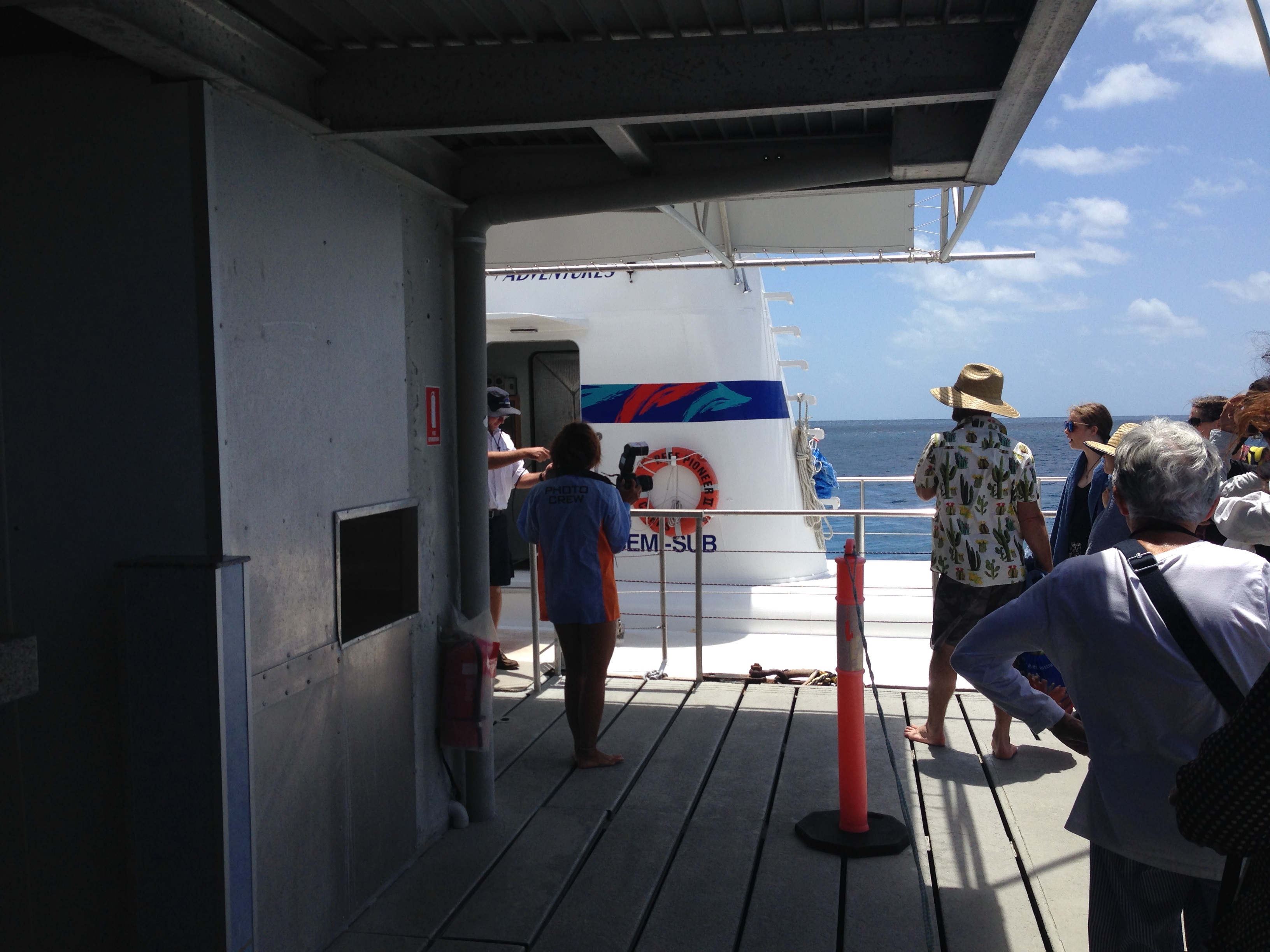
Here we are on the platform waiting to board the Semi-Submersible boat that has windows below the waterline so we could see the fish and the coral. This boat made about a 30-minute trip around the anchored platform.
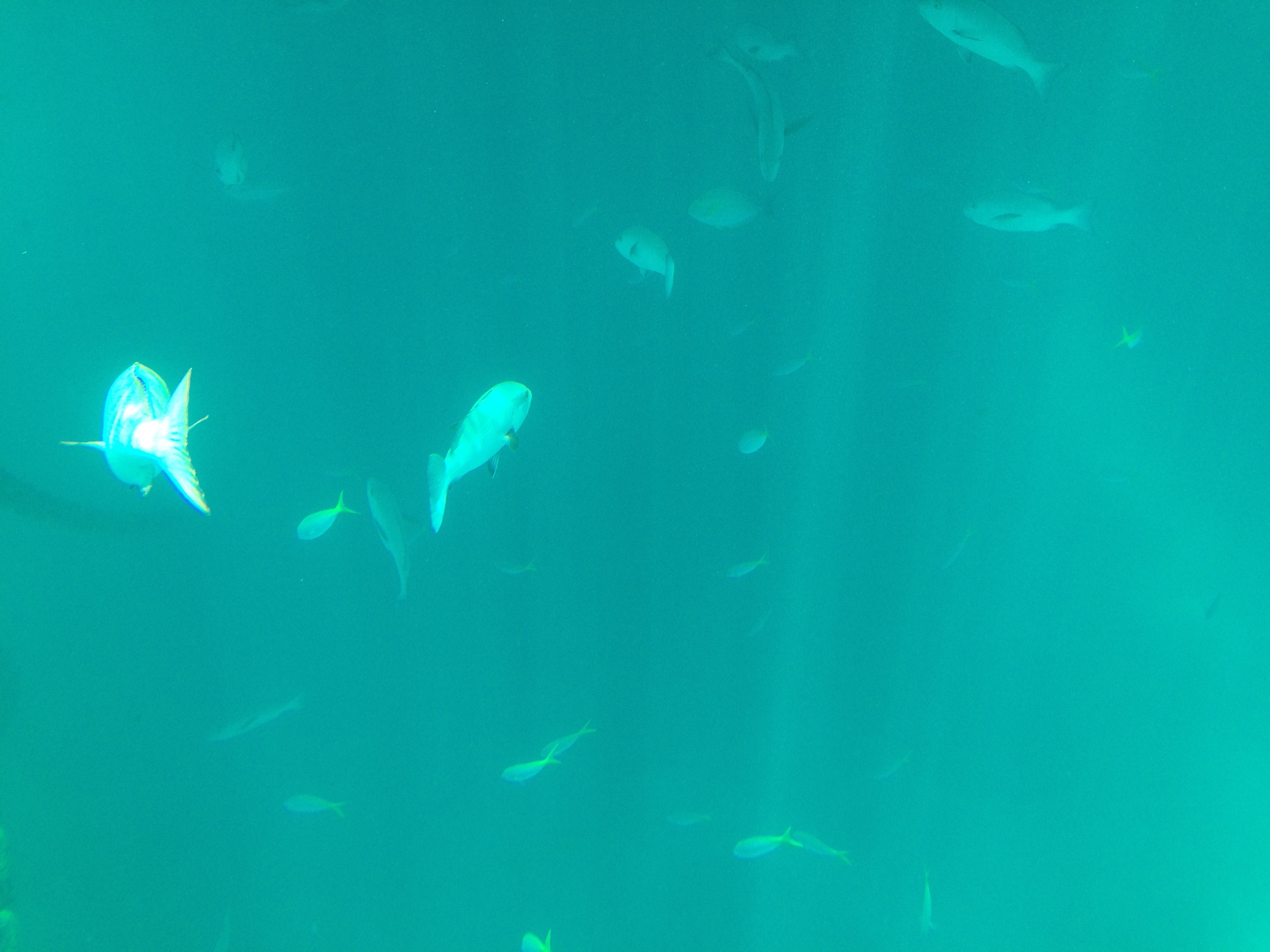
Here we are seated inside the submersible watching the fish. Unfortunately, the water was murky on this day and visibility was poor.
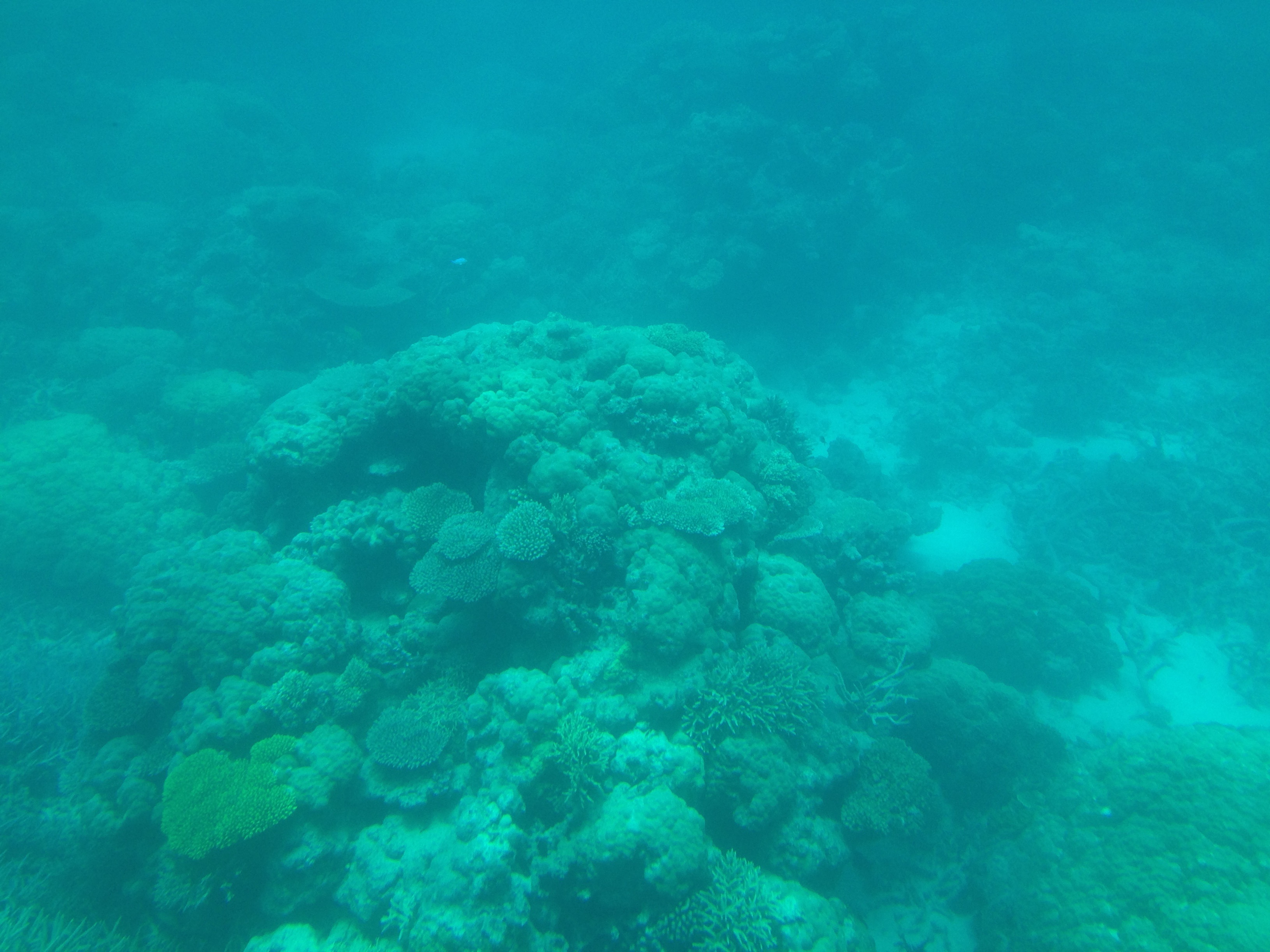
This is some of the coral we could see. At this depth the colors are mostly blue-green due to the filtering effect of the water. We could have gone SCUBA diving here, but we decided not to due to the poor visibility. It was still an interesting afternoon.
Sydney
On October 9th, we had our first day in Sydney.
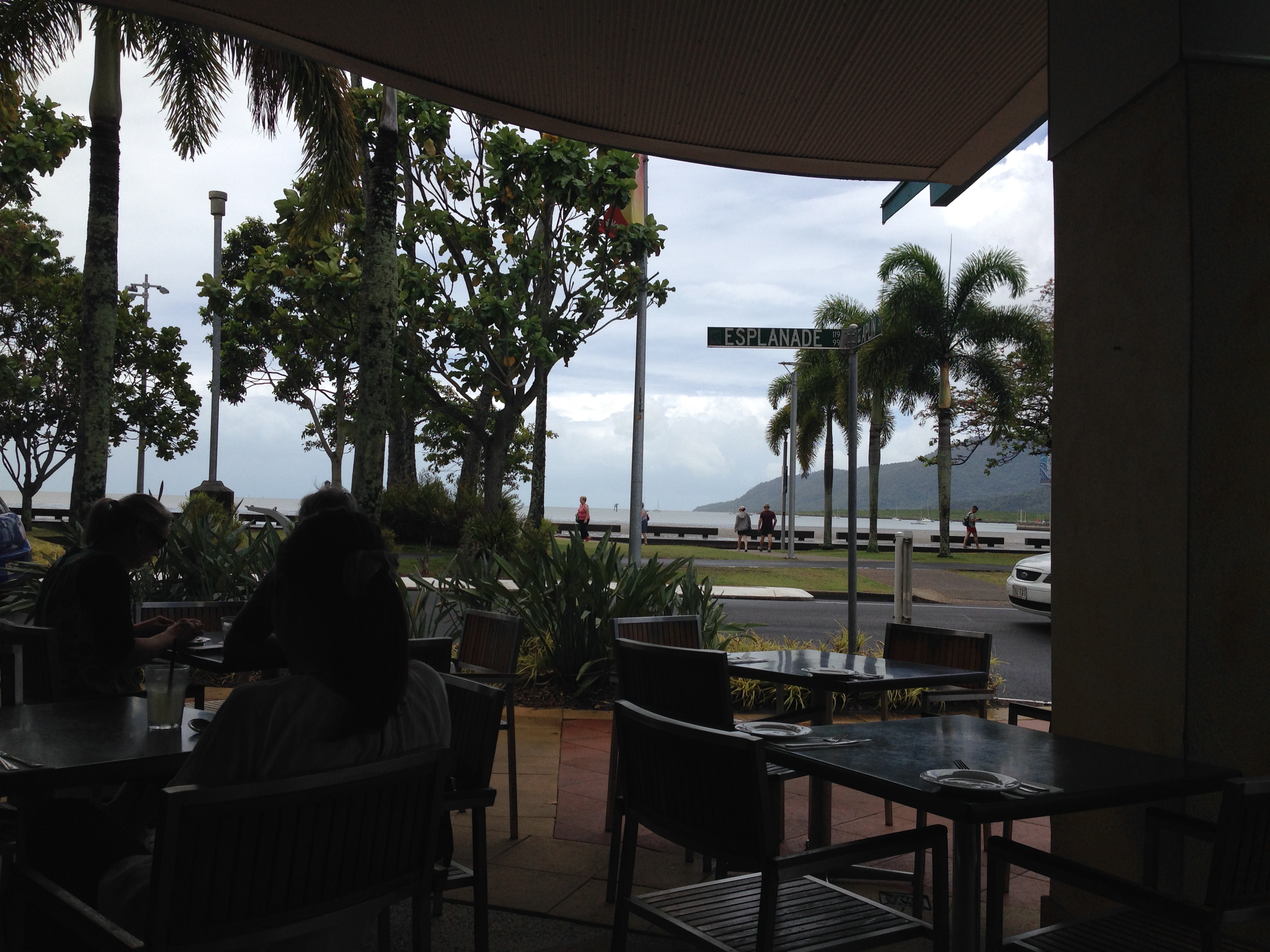
Our first day in Sydney, we had lunch in a restaurant on the Esplanade. Notice the beach. The tide is in.
There are many shops and restaurants along this street. We did a lot of shopping on this street.
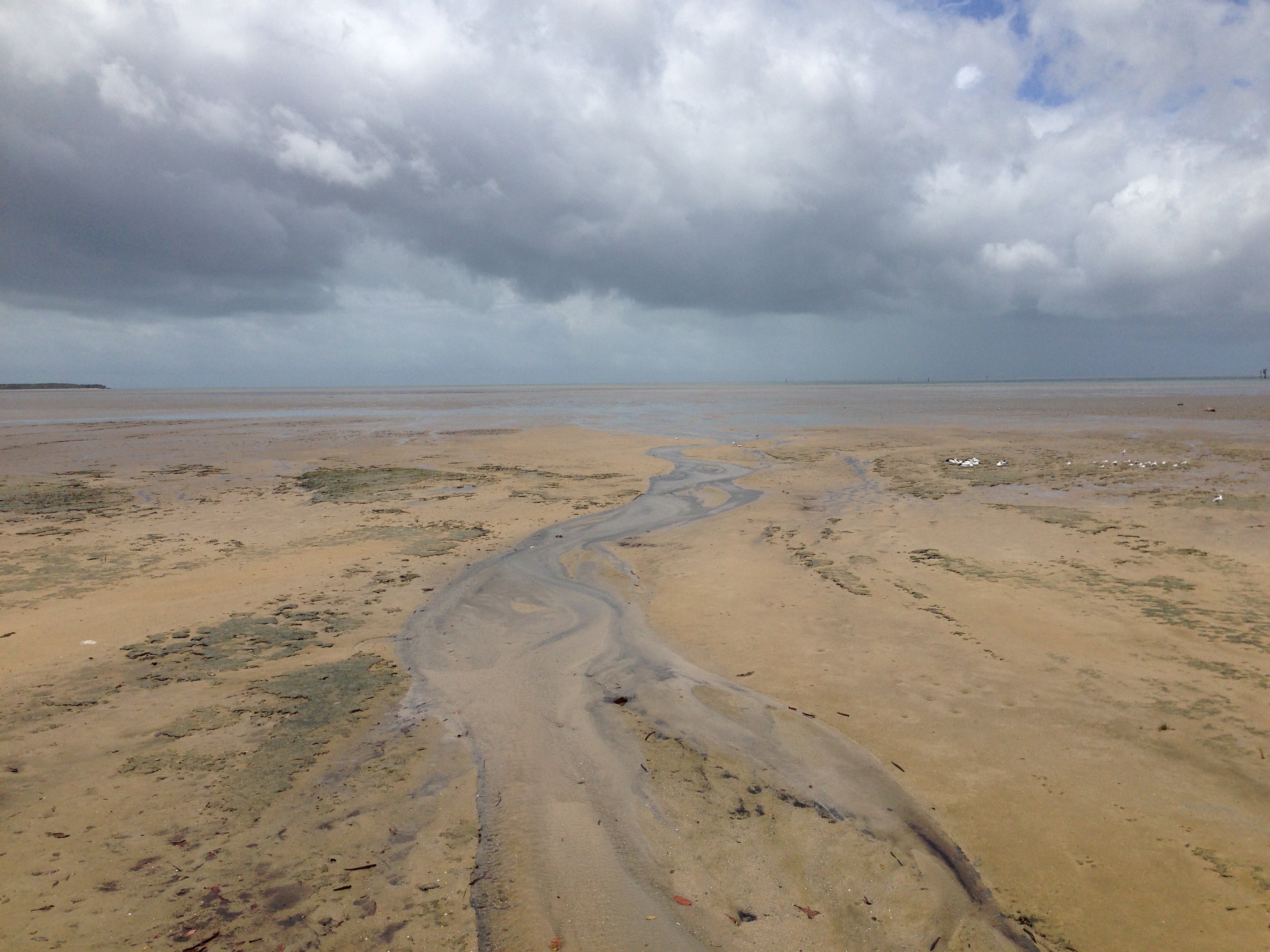
How bleak these tidal flats seem when the tide is out. What a difference.
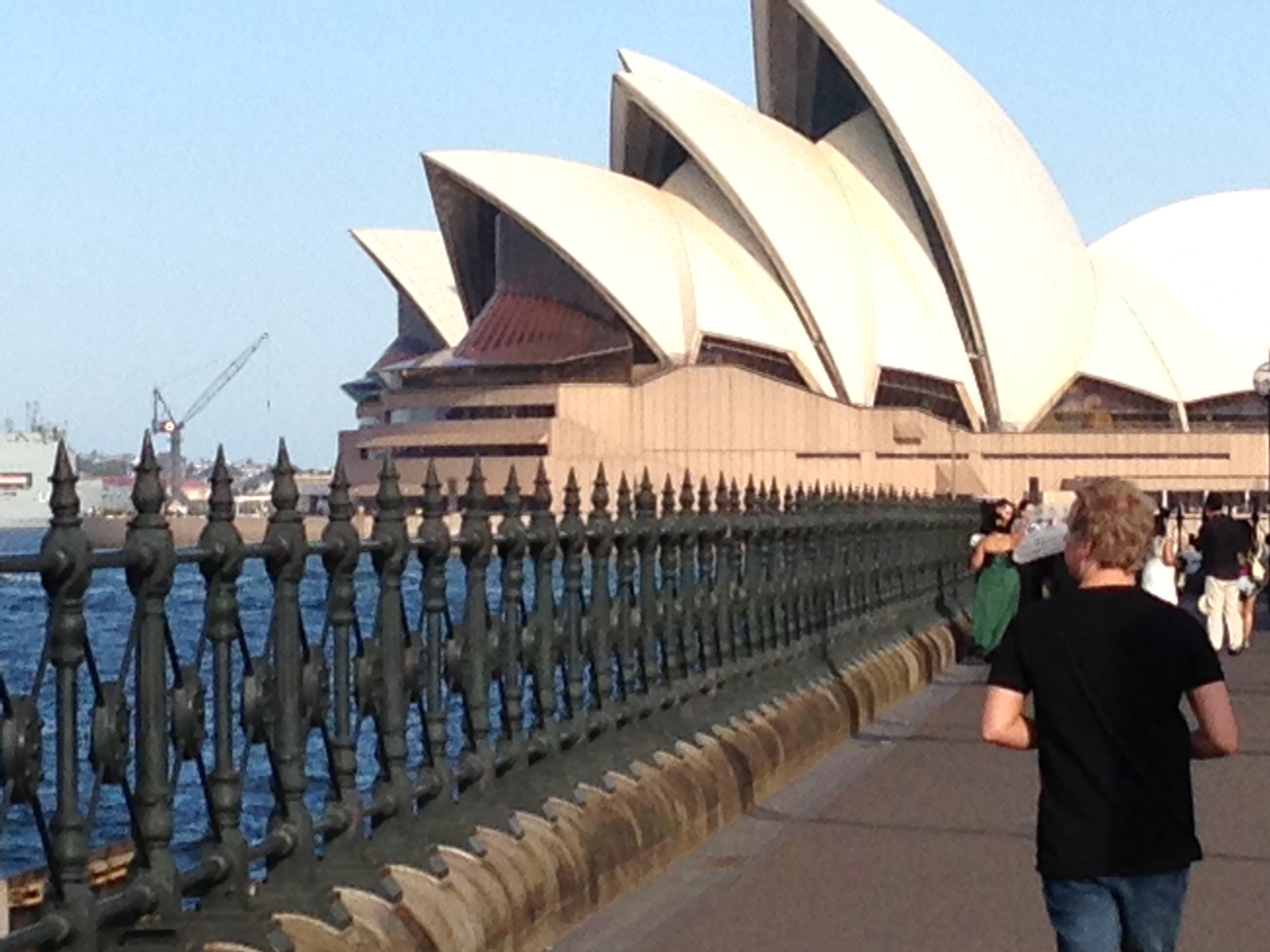
The next day we were taken to the harbor where we could see two famous landmarks: the Sydney Opera House and the Harbor Bridge.
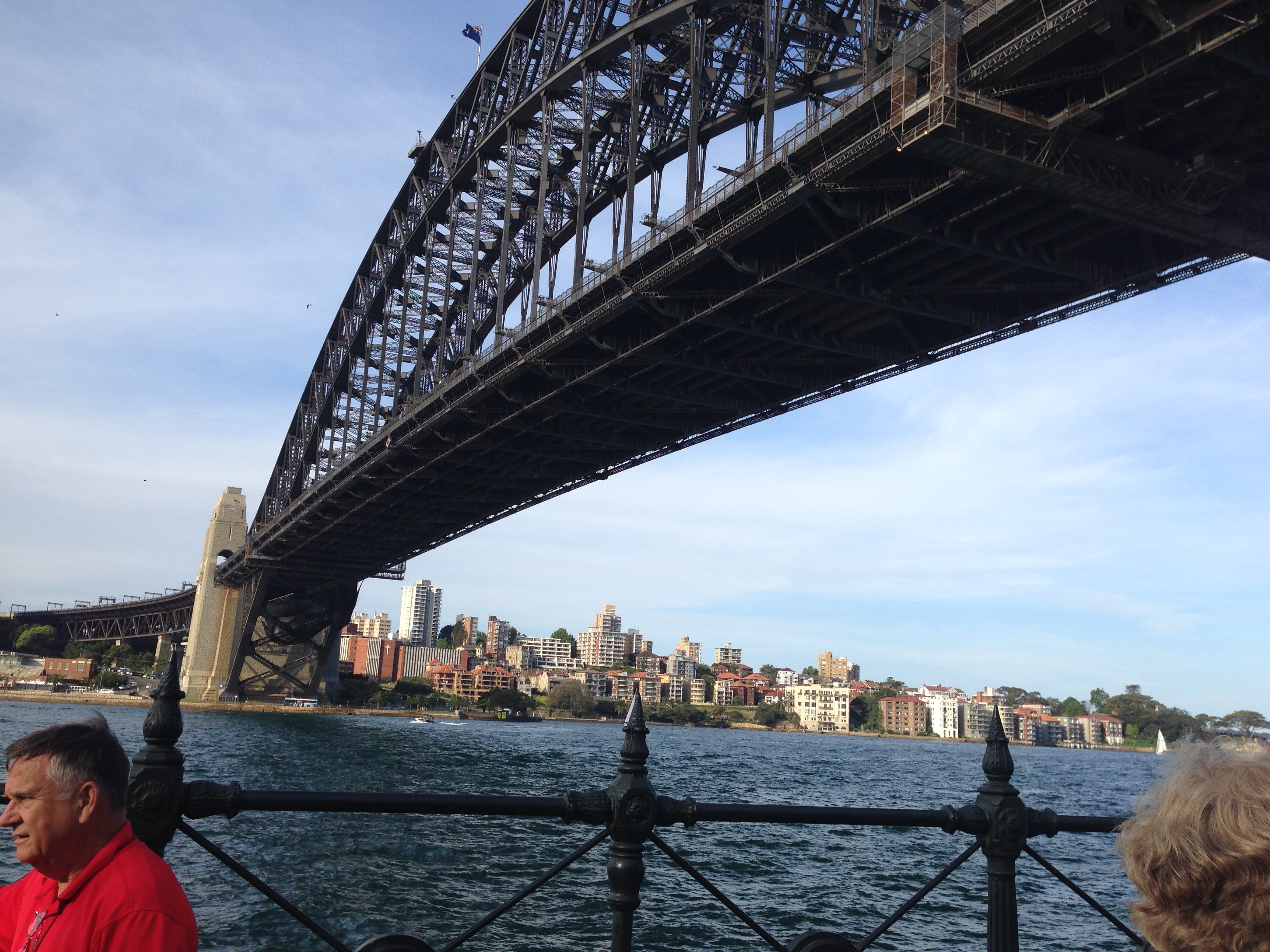
This view of the harbor bridge is for my engineerining colleagues because it shows how the structure is anchored at one of the ends. Note the massive, but artistic, stonework and concrete that holds it. To me, there is a certain elegance in this design.
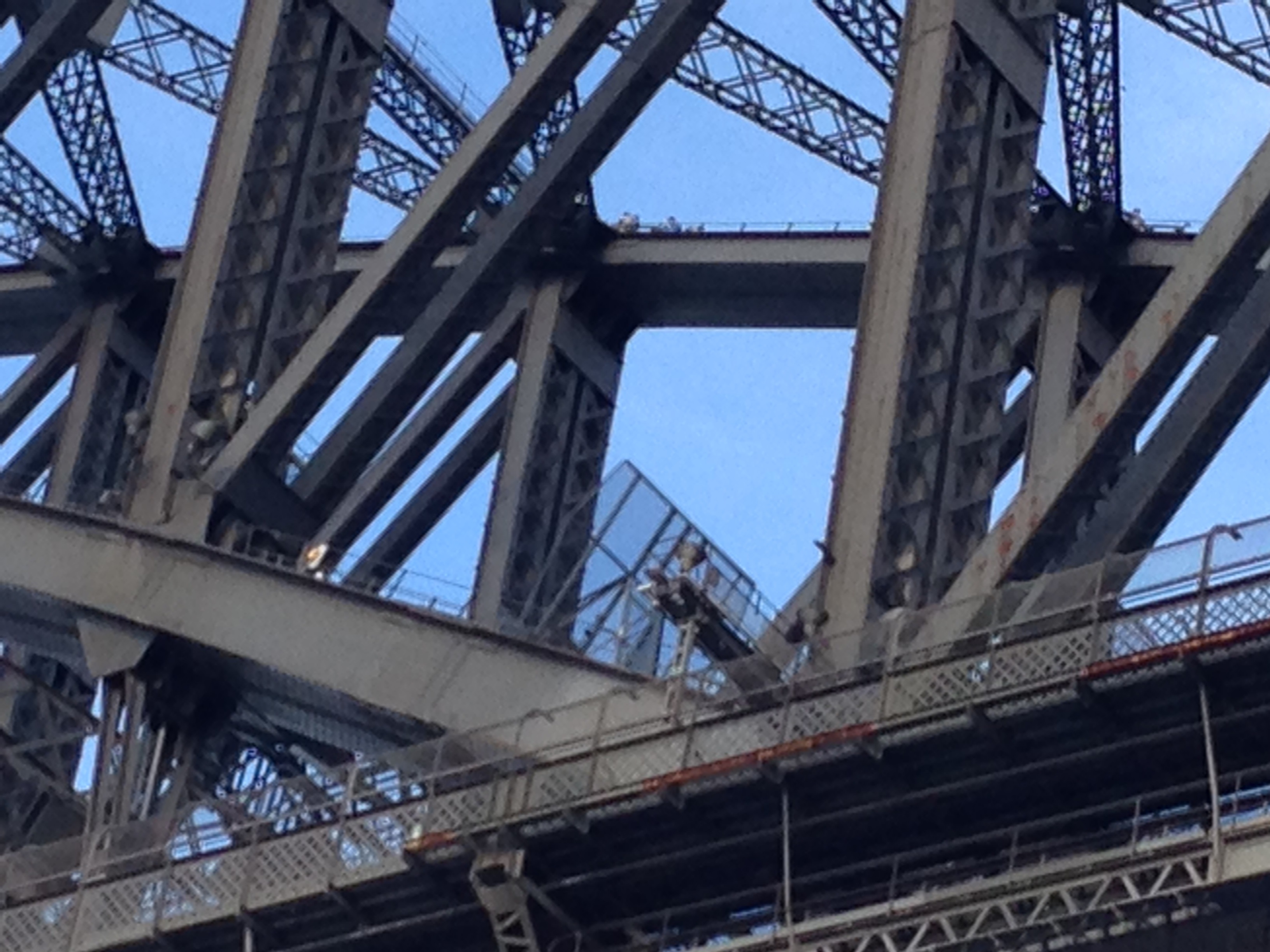
One of the activities we decided to skip was walking the superstructure of the bridge. You can see a group of walkers near the top. You have to pay for this privilege. They go in groups of about a dozen with a guide. The walkers are required to wear a provided drab jumpsuit so as to avoid distracting the motorists far below. They have a safety line clipped to the railing so no one will be blown off due to wind gusts. At the end of the walk, they can also buy a t-shirt stating that they walked the bridge.
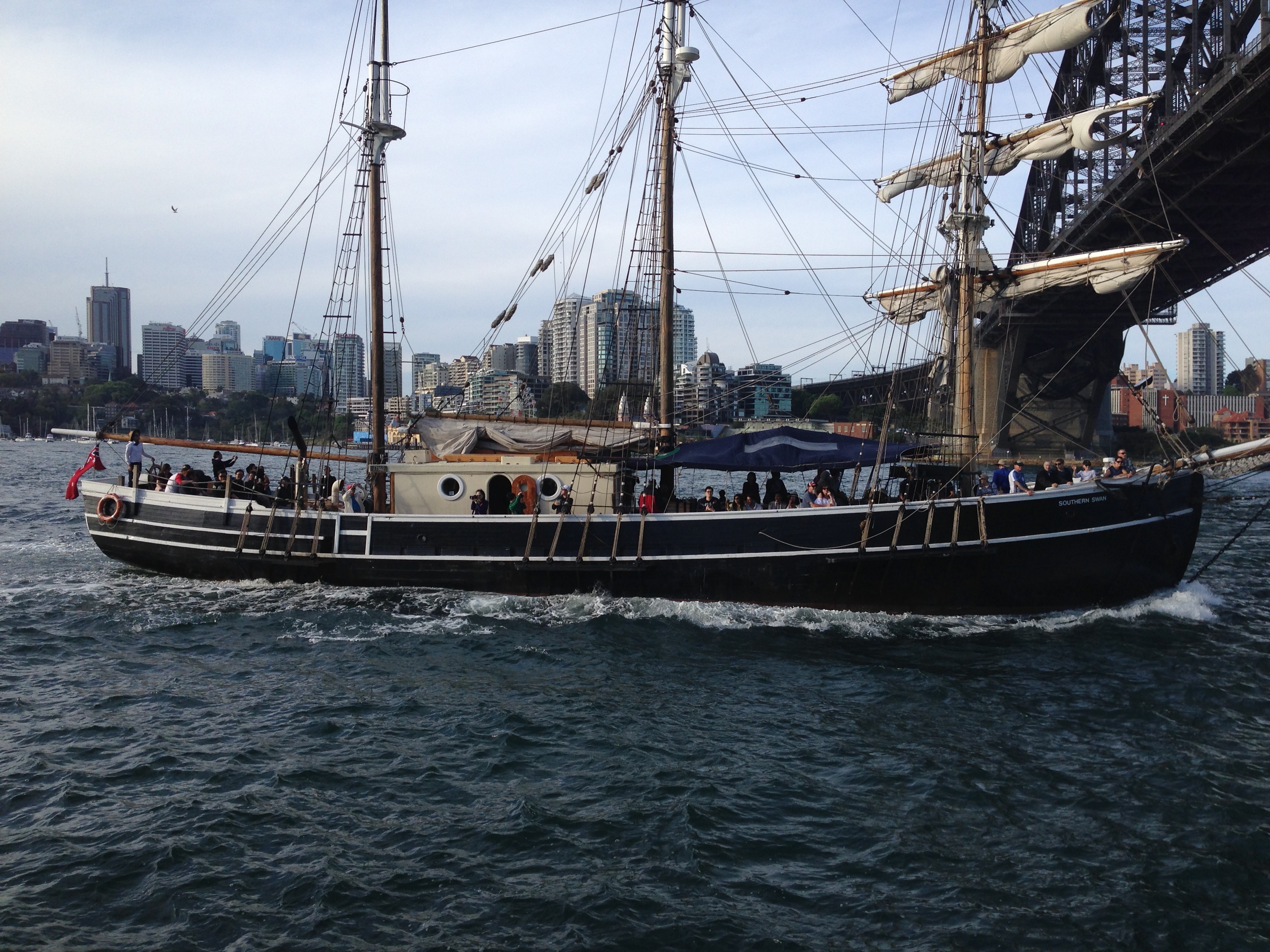
There were all kinds of boats moving on the river. This was taken near the base of the bridge.
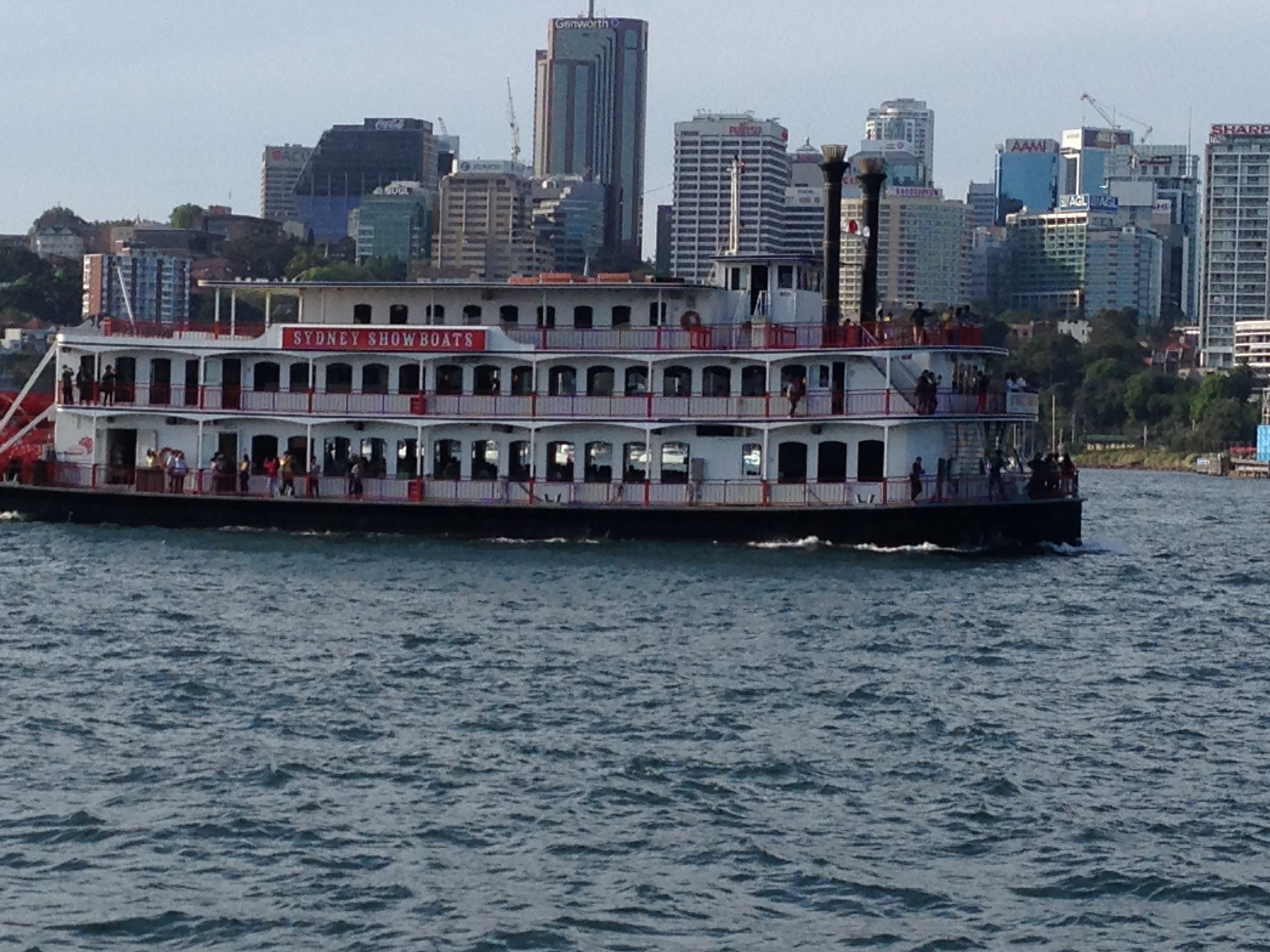
Here is another tour boat going by.
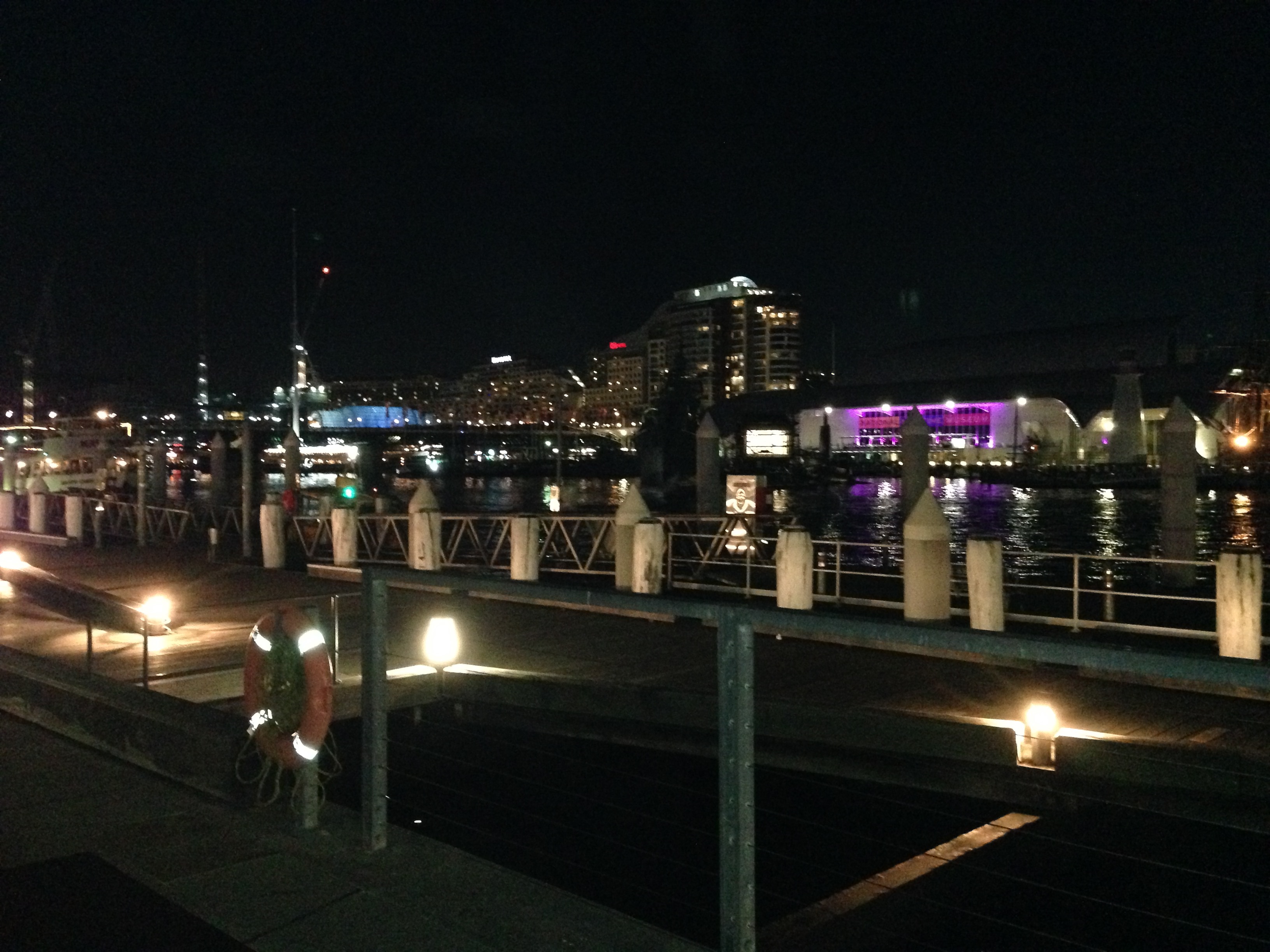
That evening our group dined in Sydney. This was taken on the way to the restaurant.
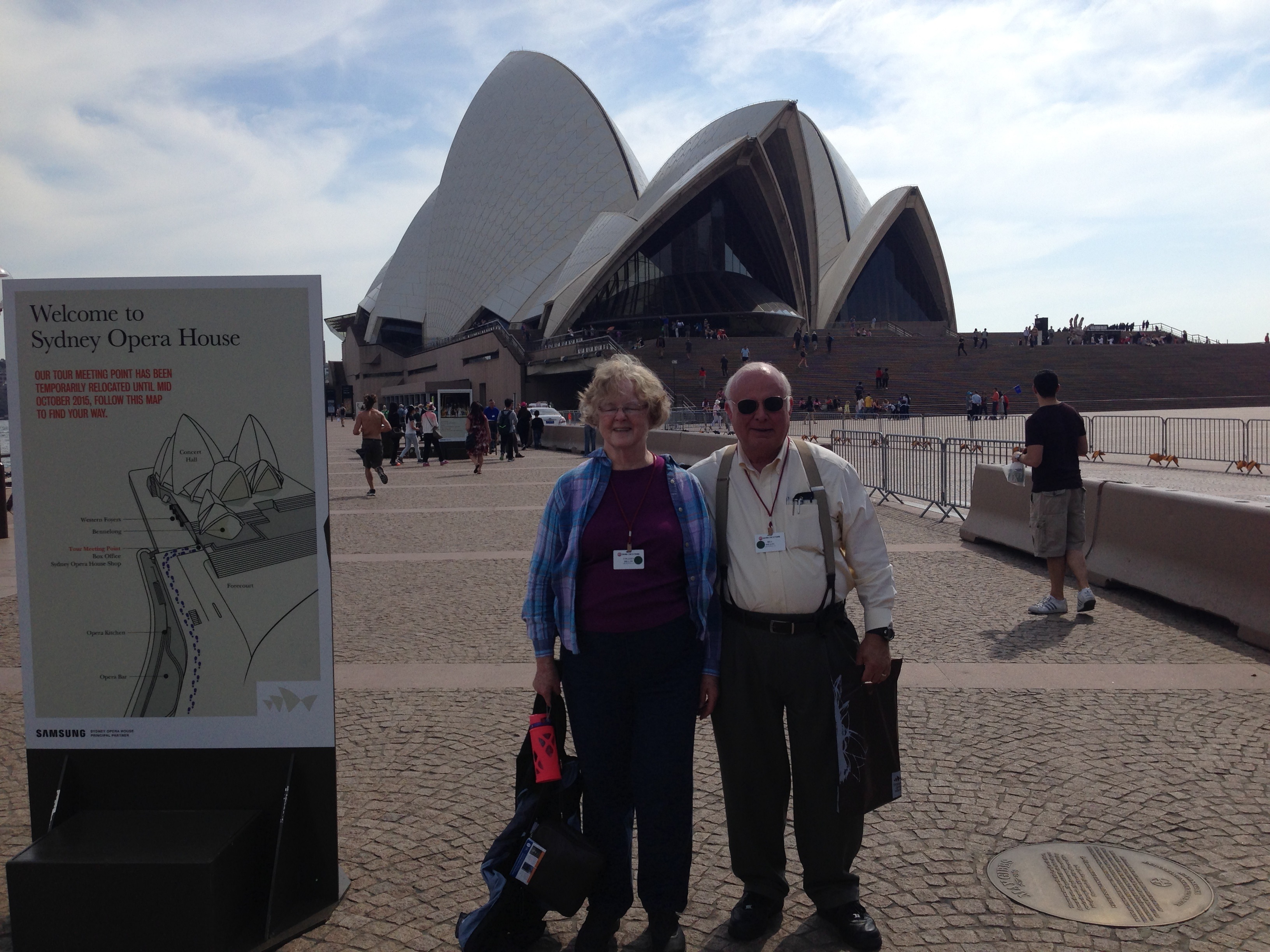
On the morning of October 11, we rode the coach to the harbor park. Our first event was a tour of the Sydney Opera House. It is large and complex.
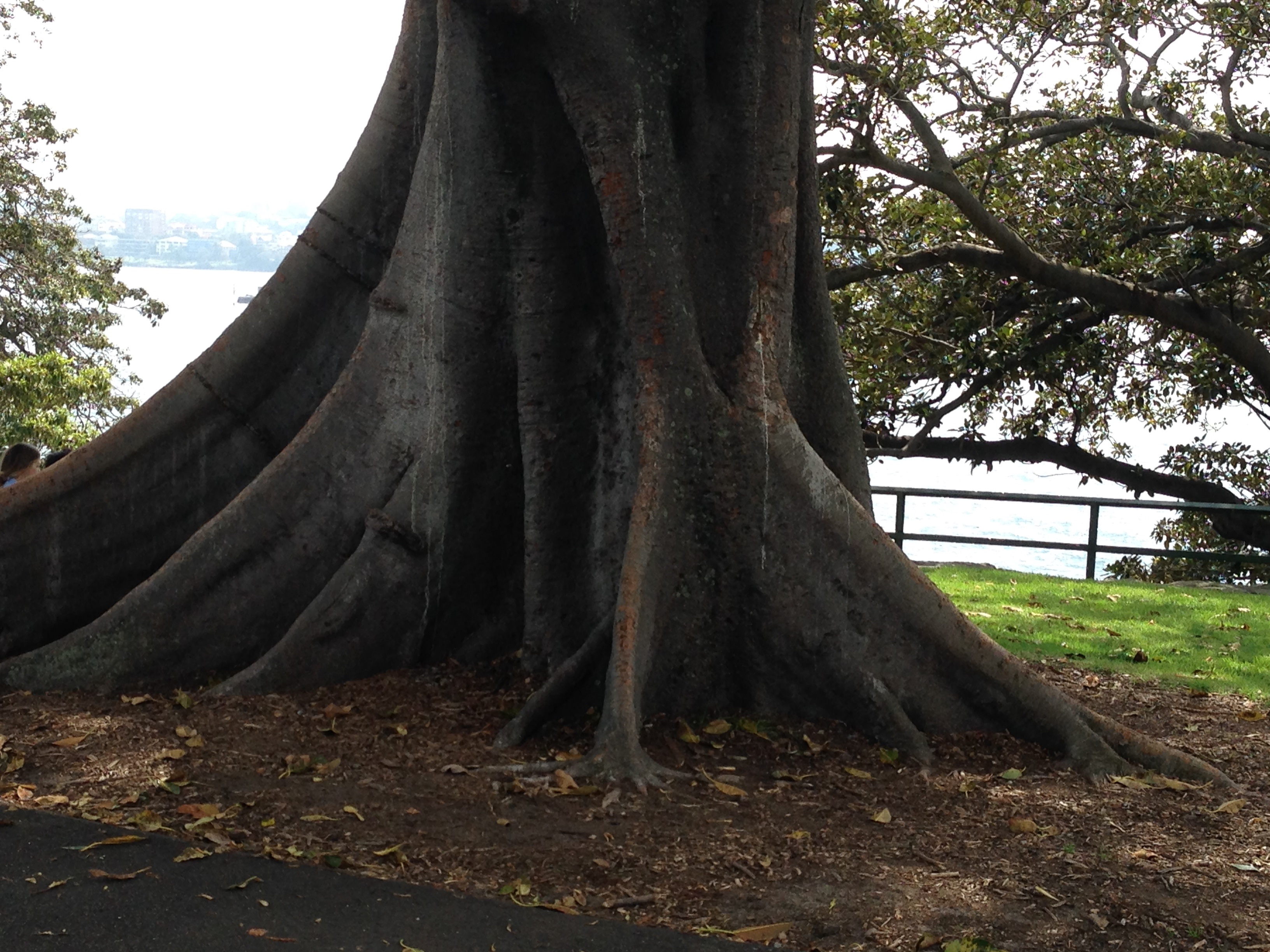
This very old Fig tree gave character to the park
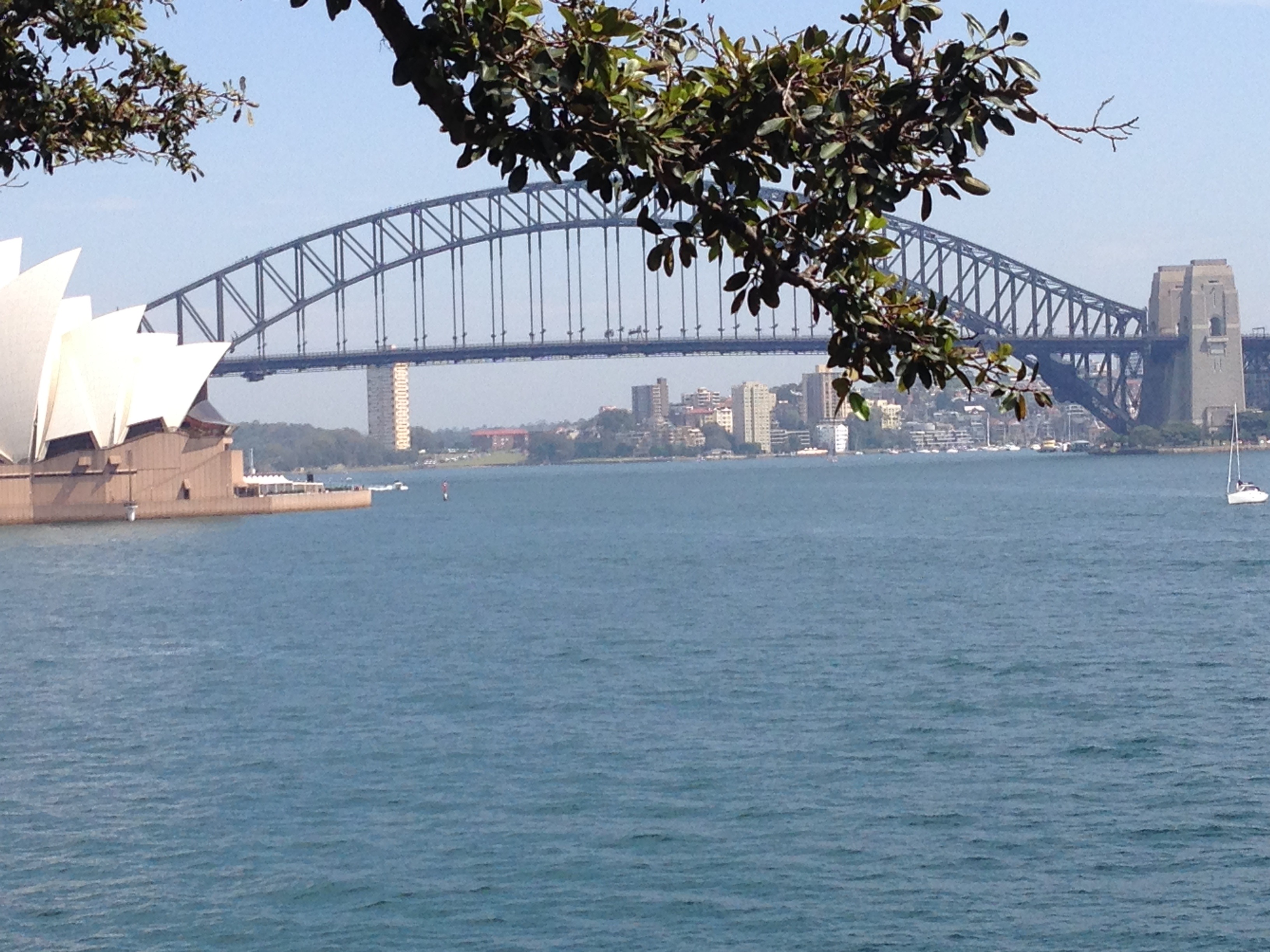
This is a view of the Harbor Bridge from the park
We will add more about the trip as time permits.
Back to Main Page



































